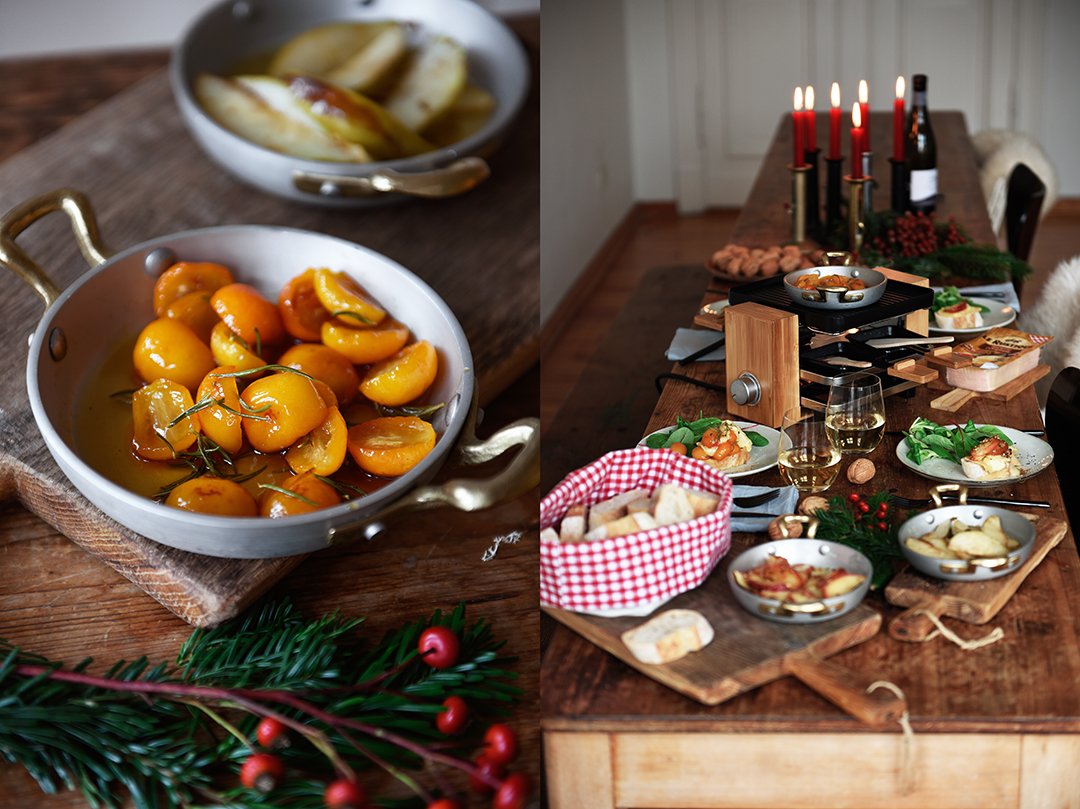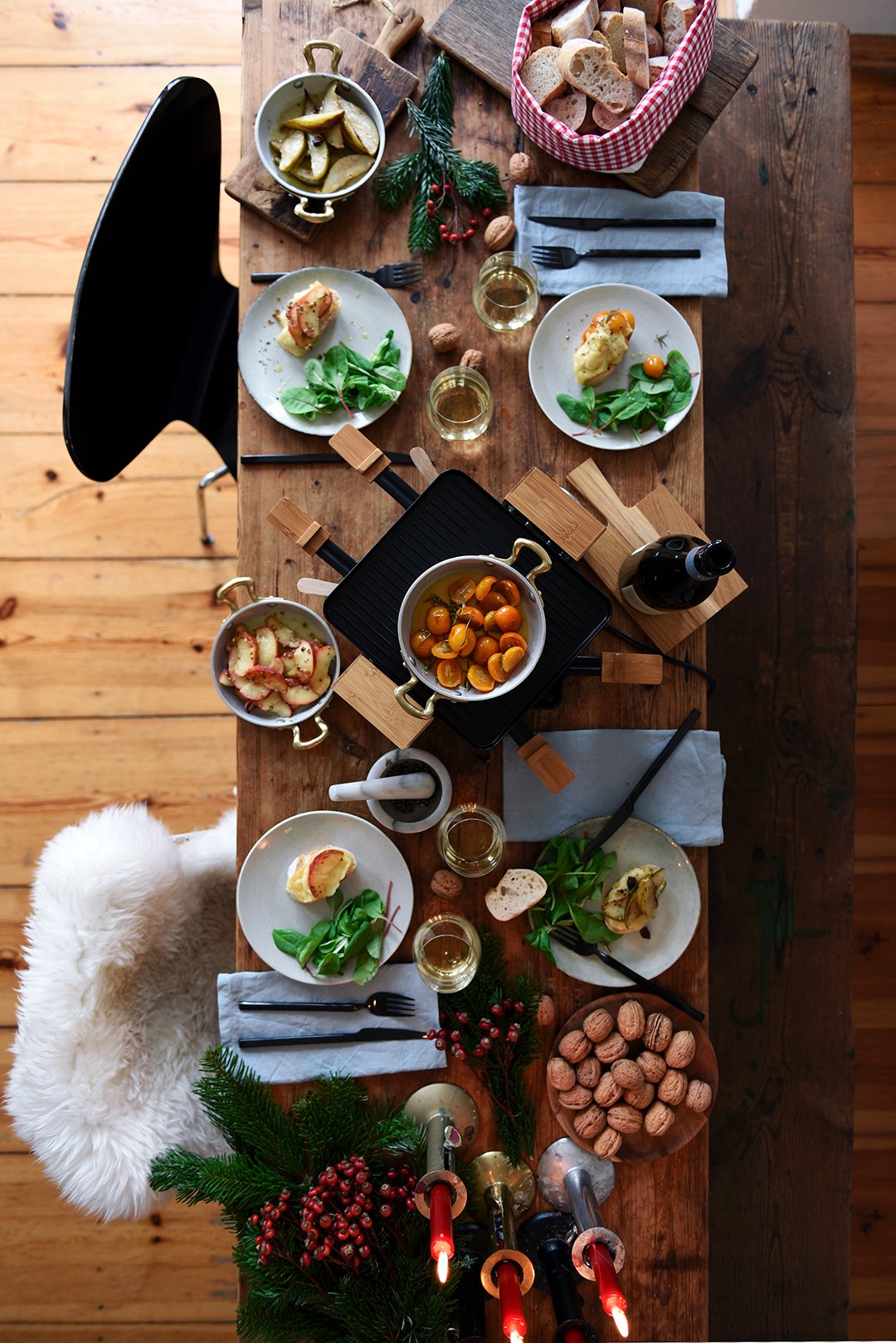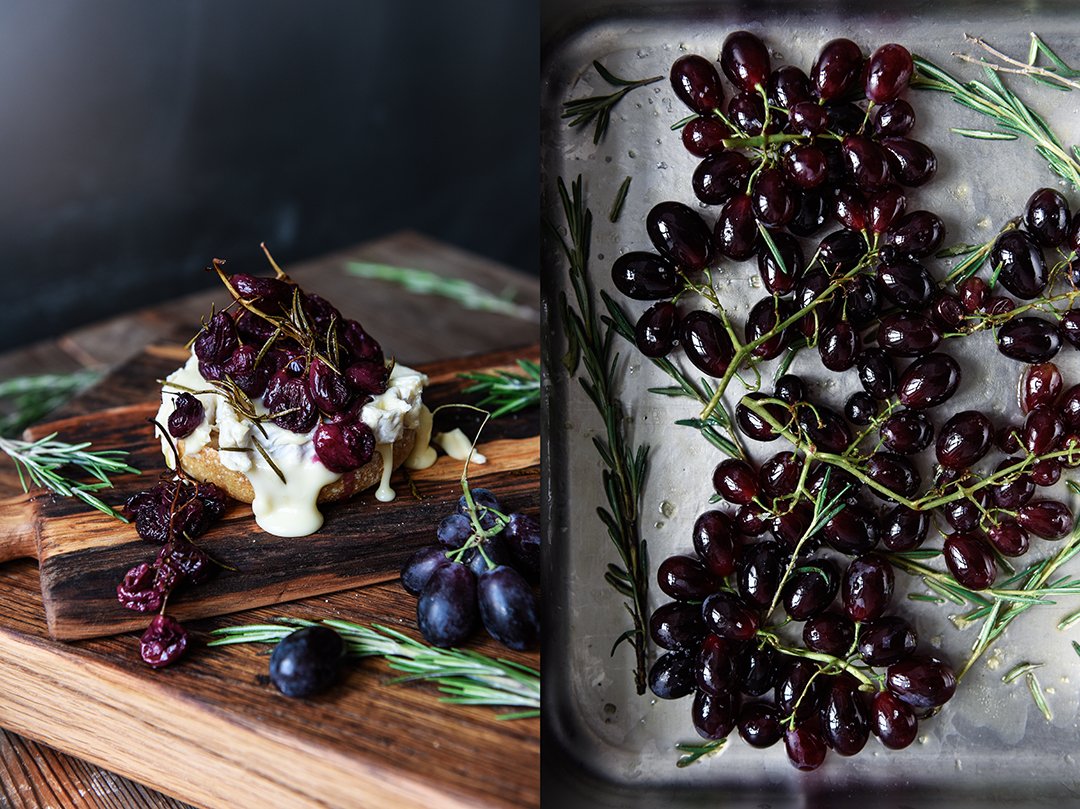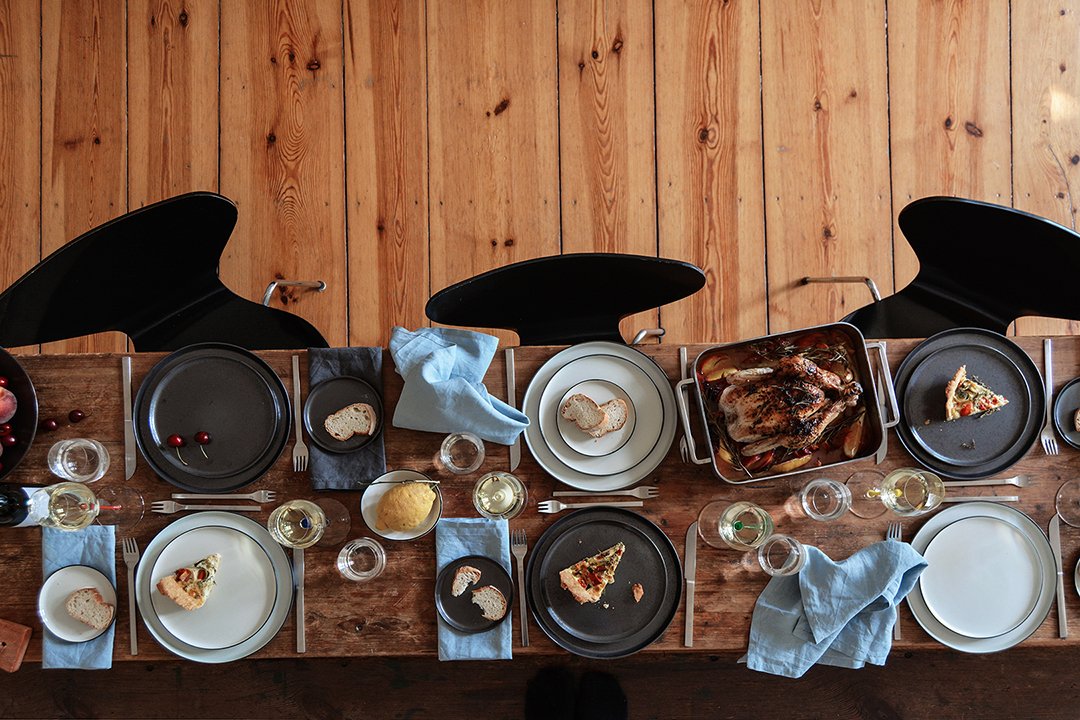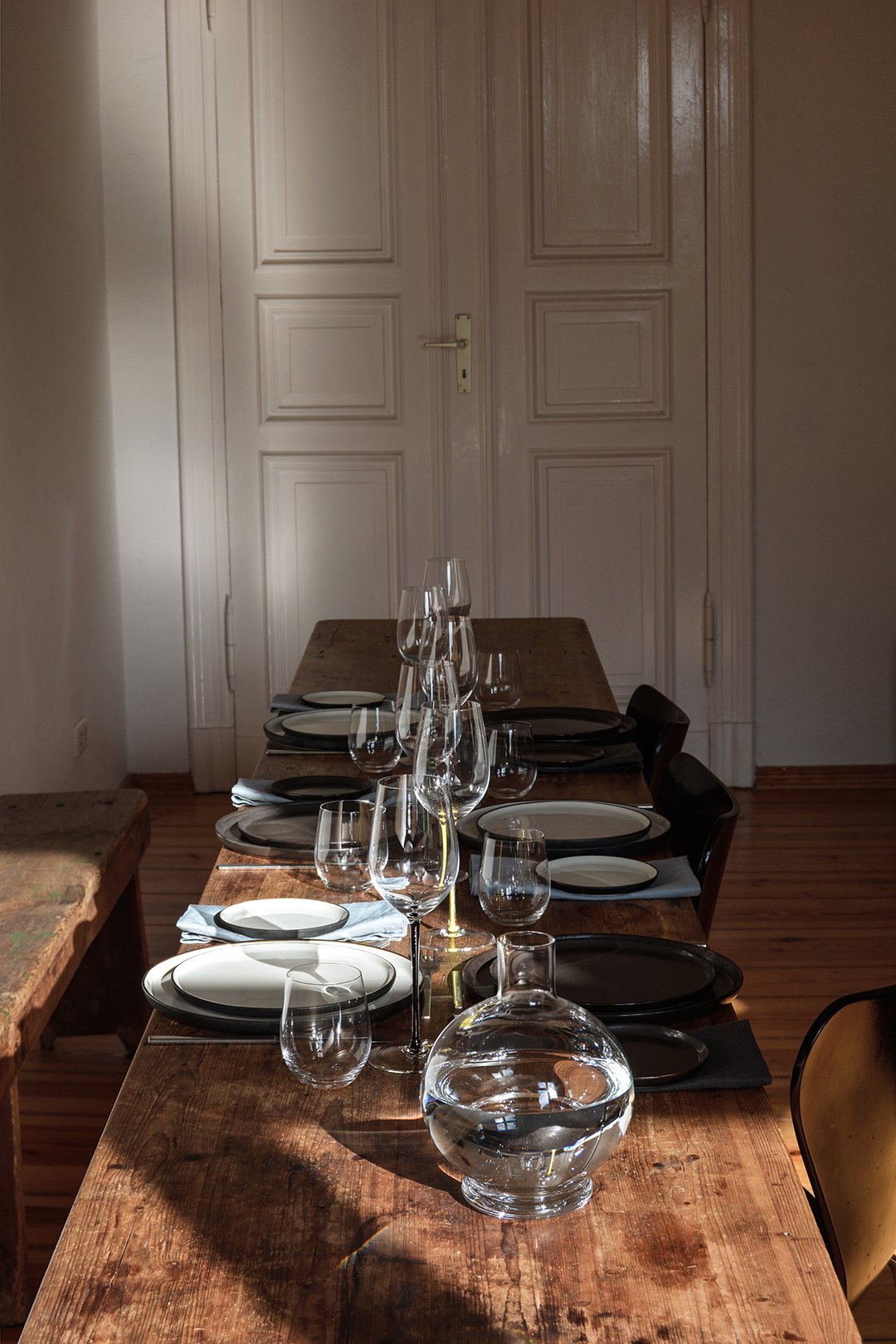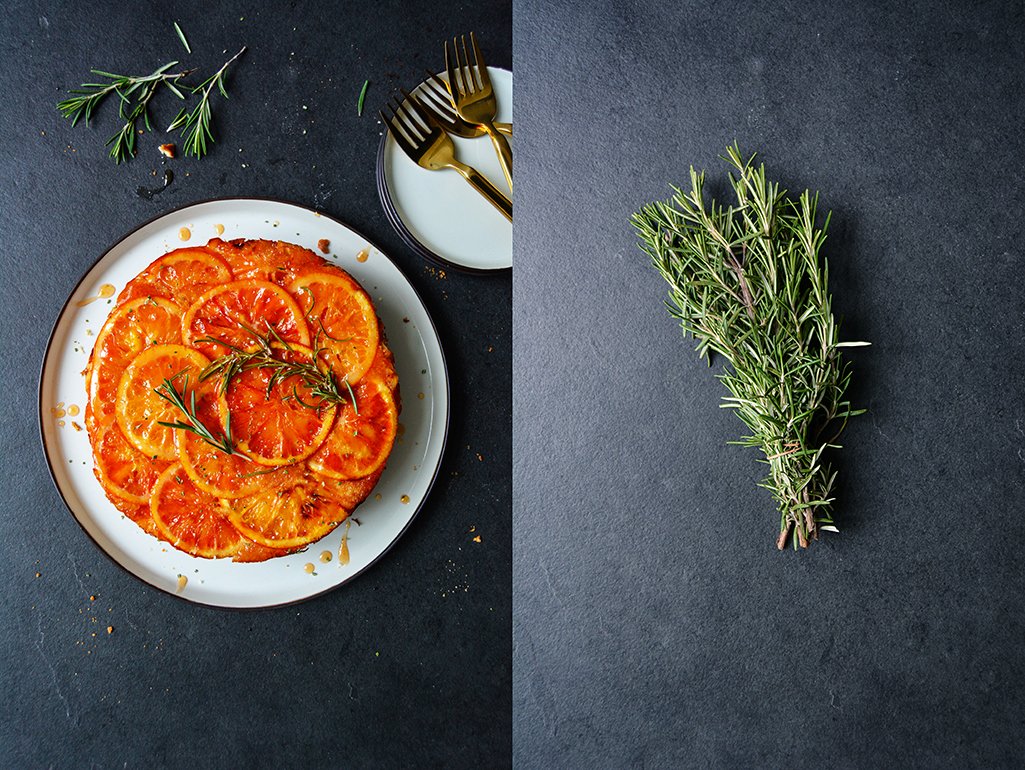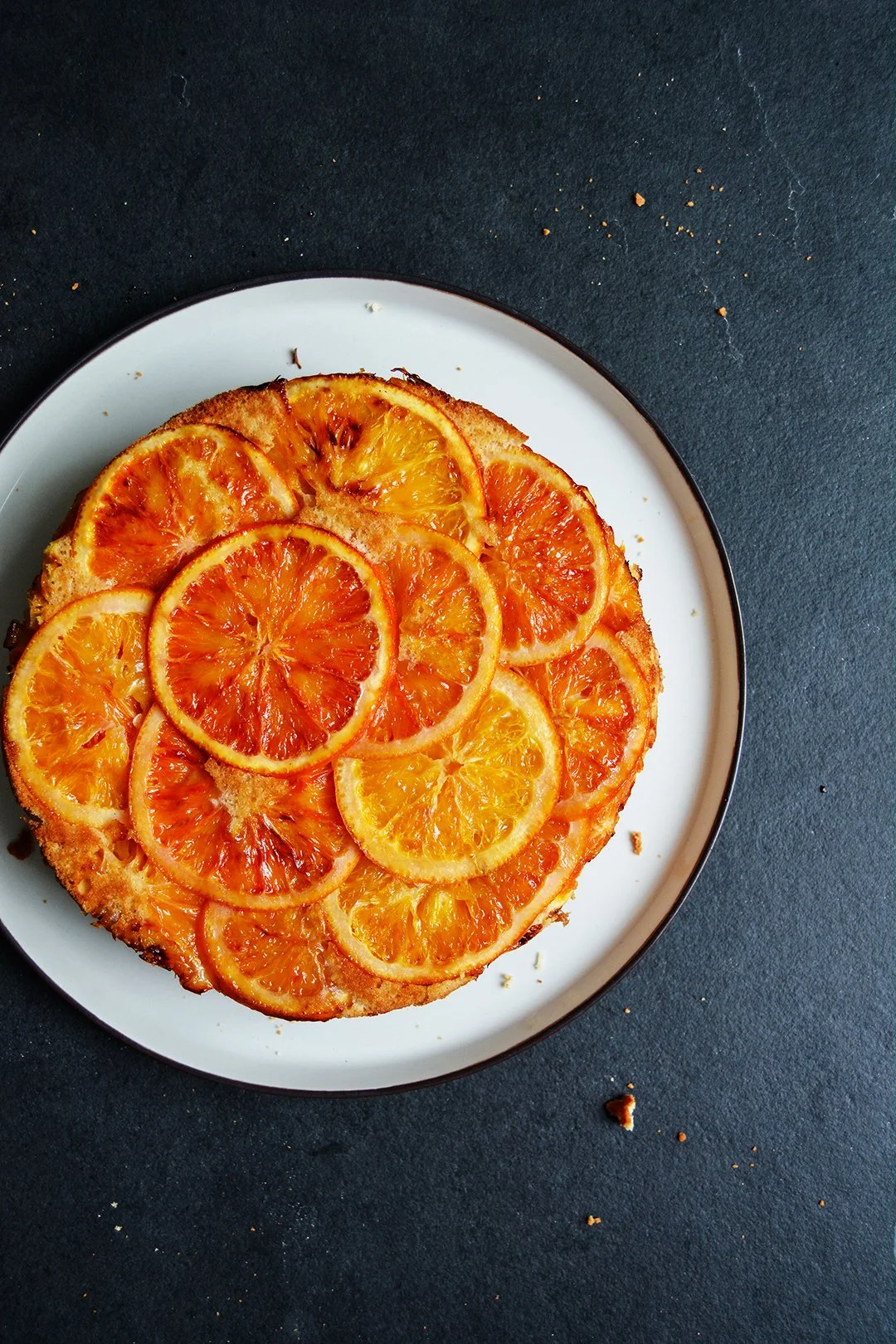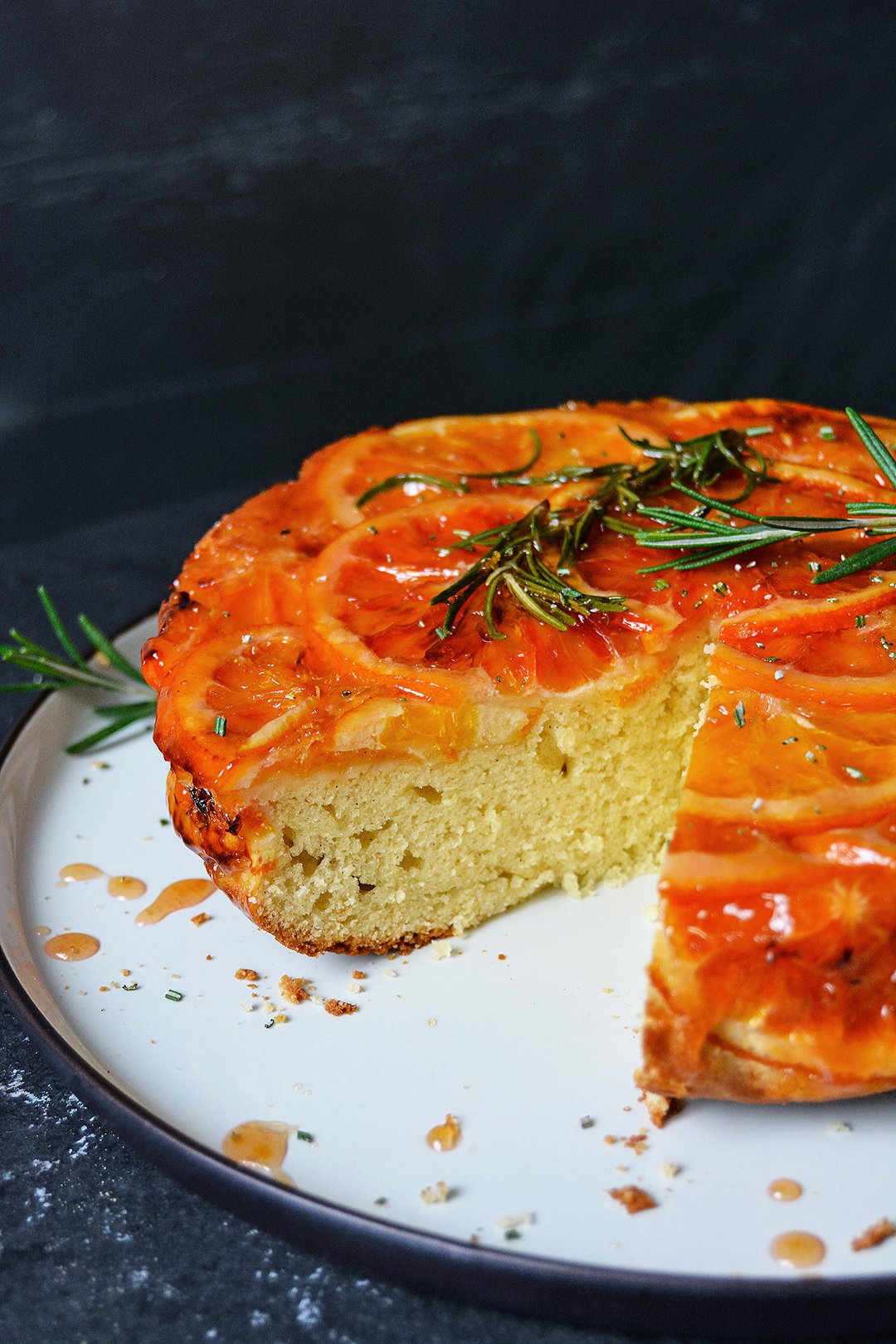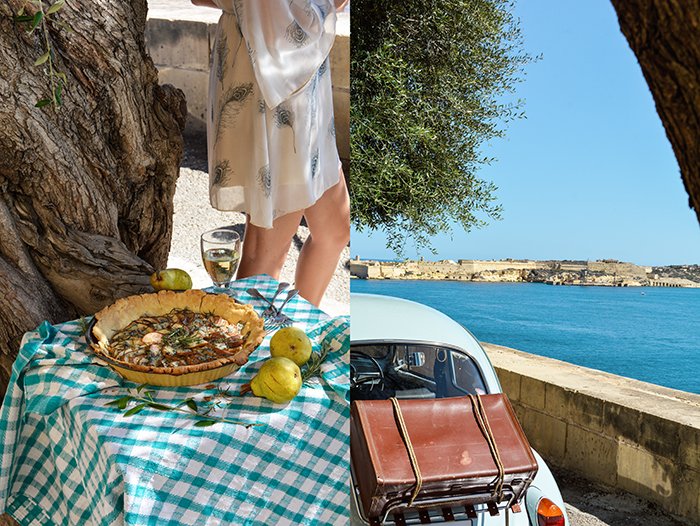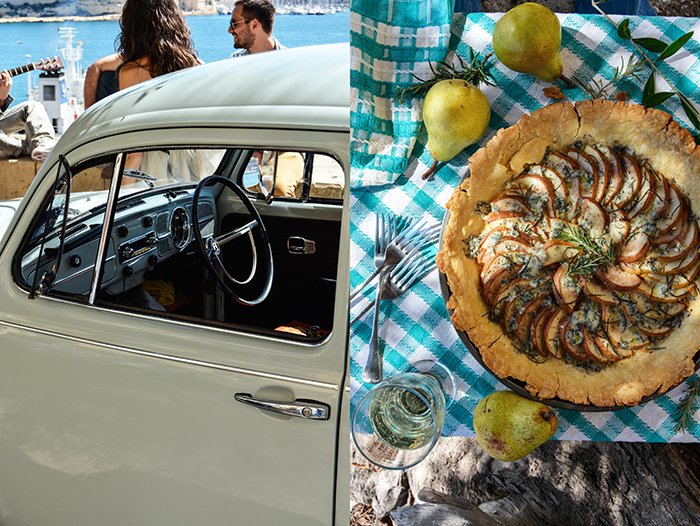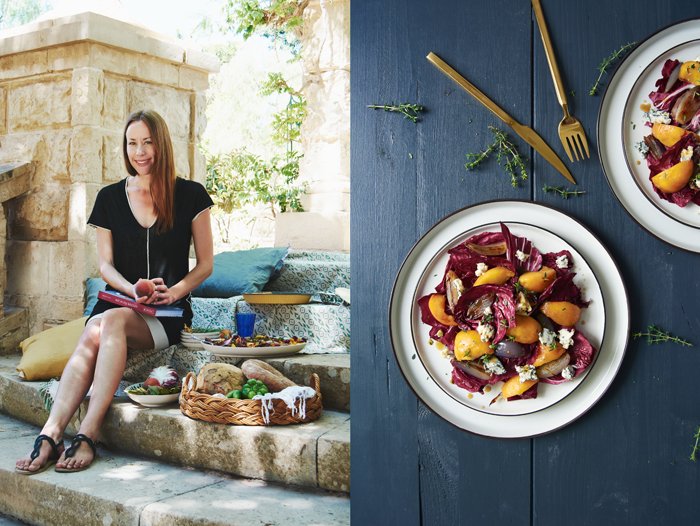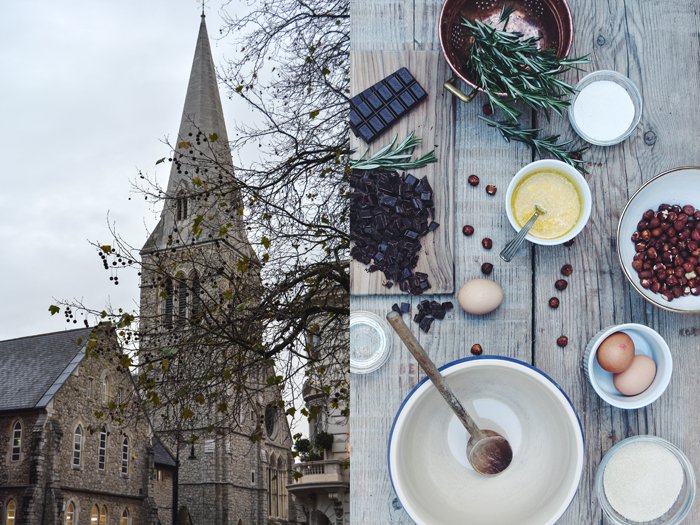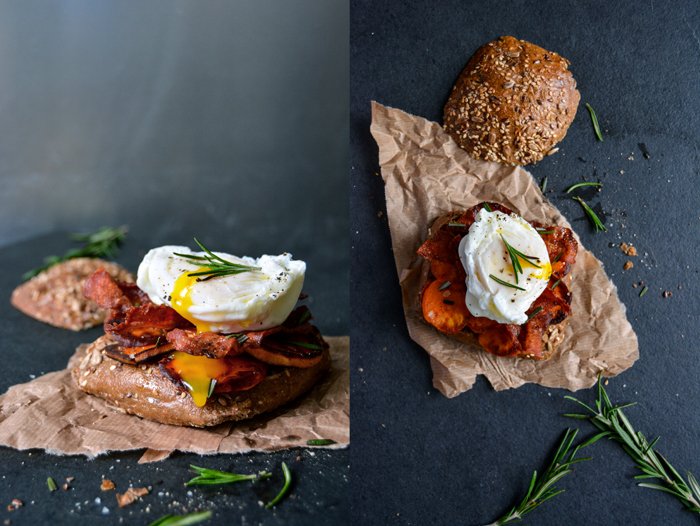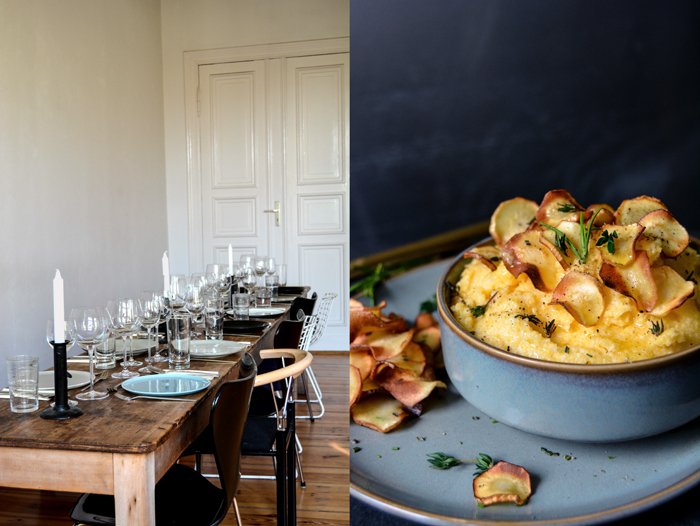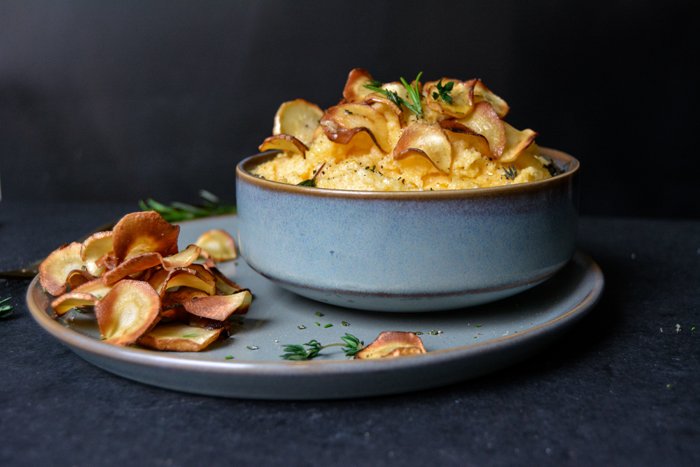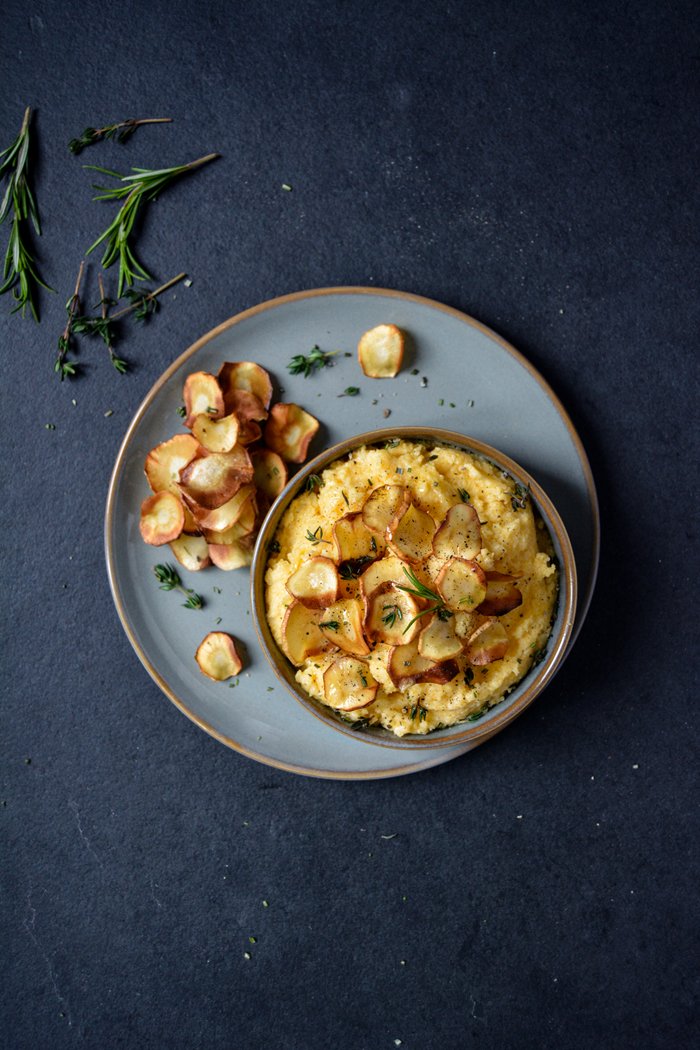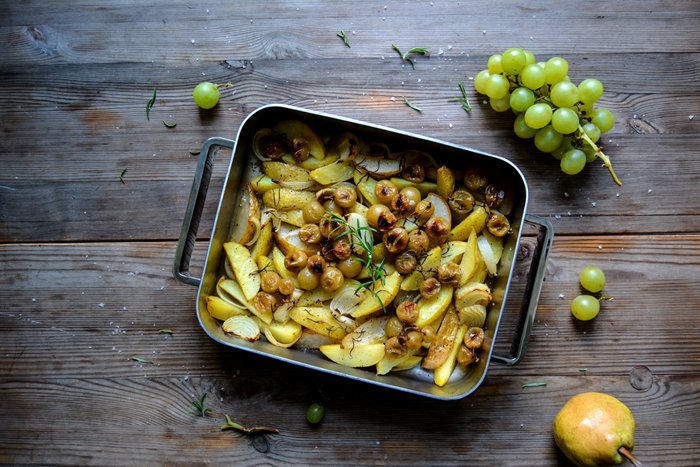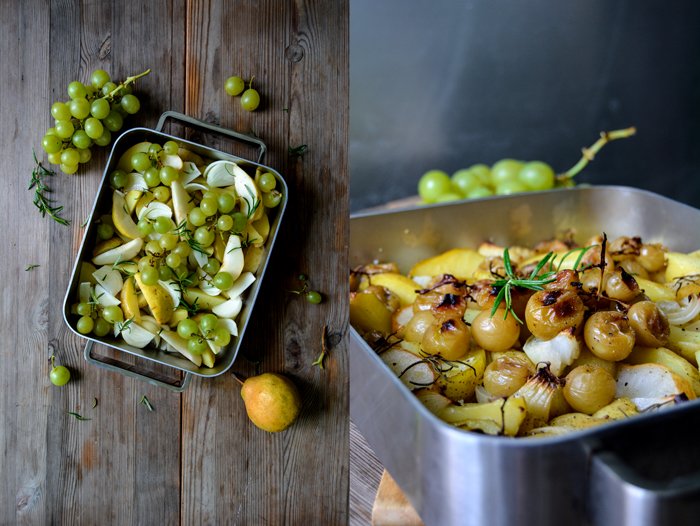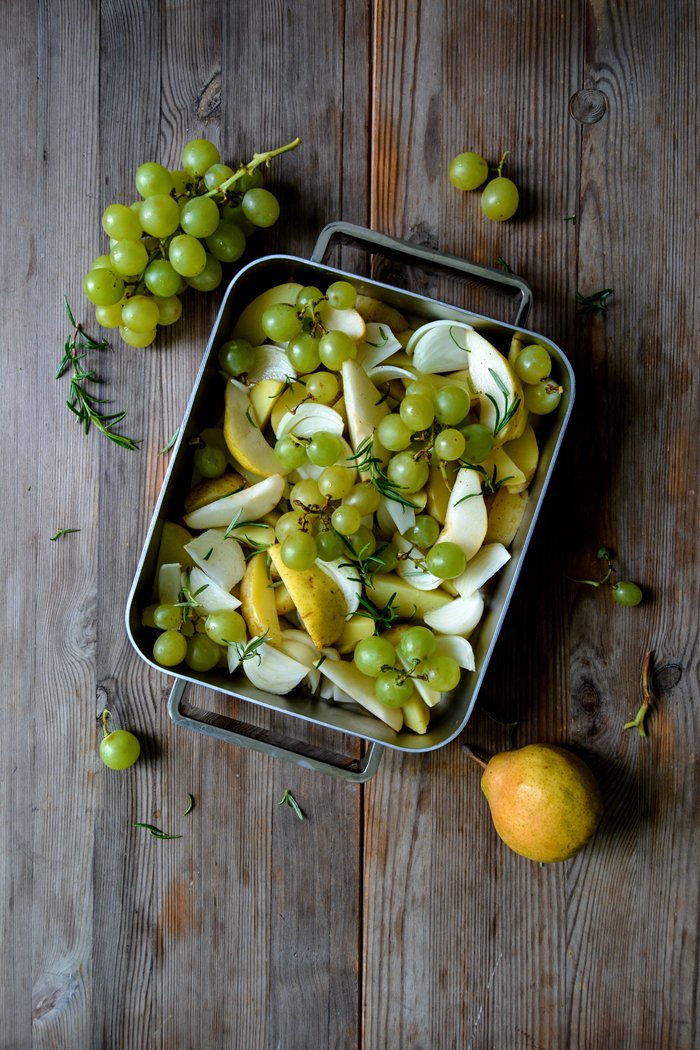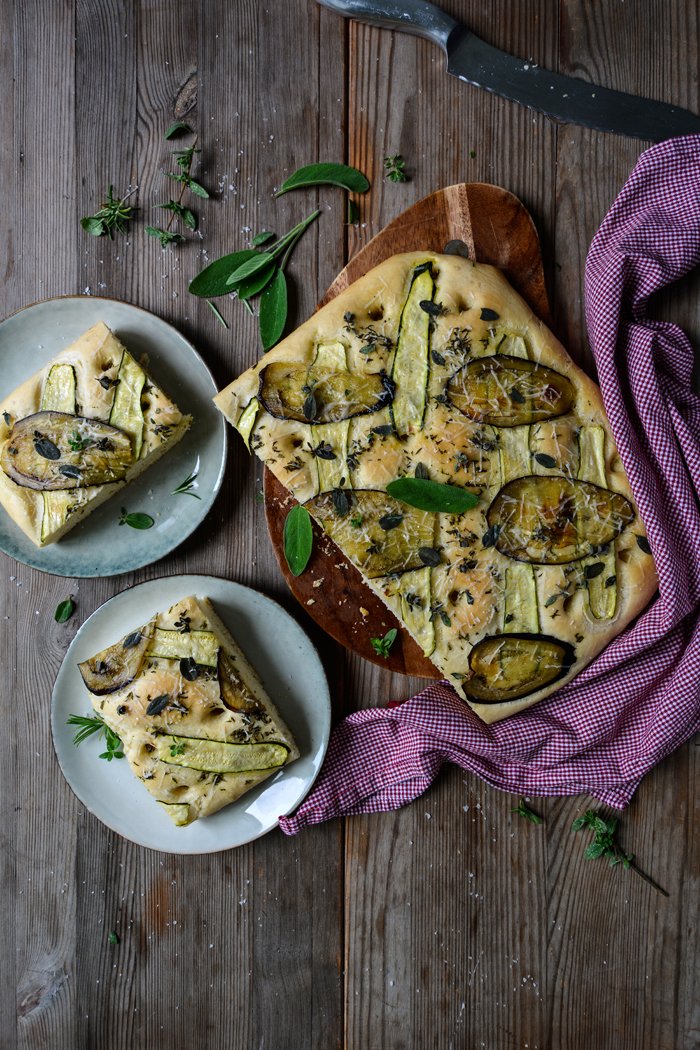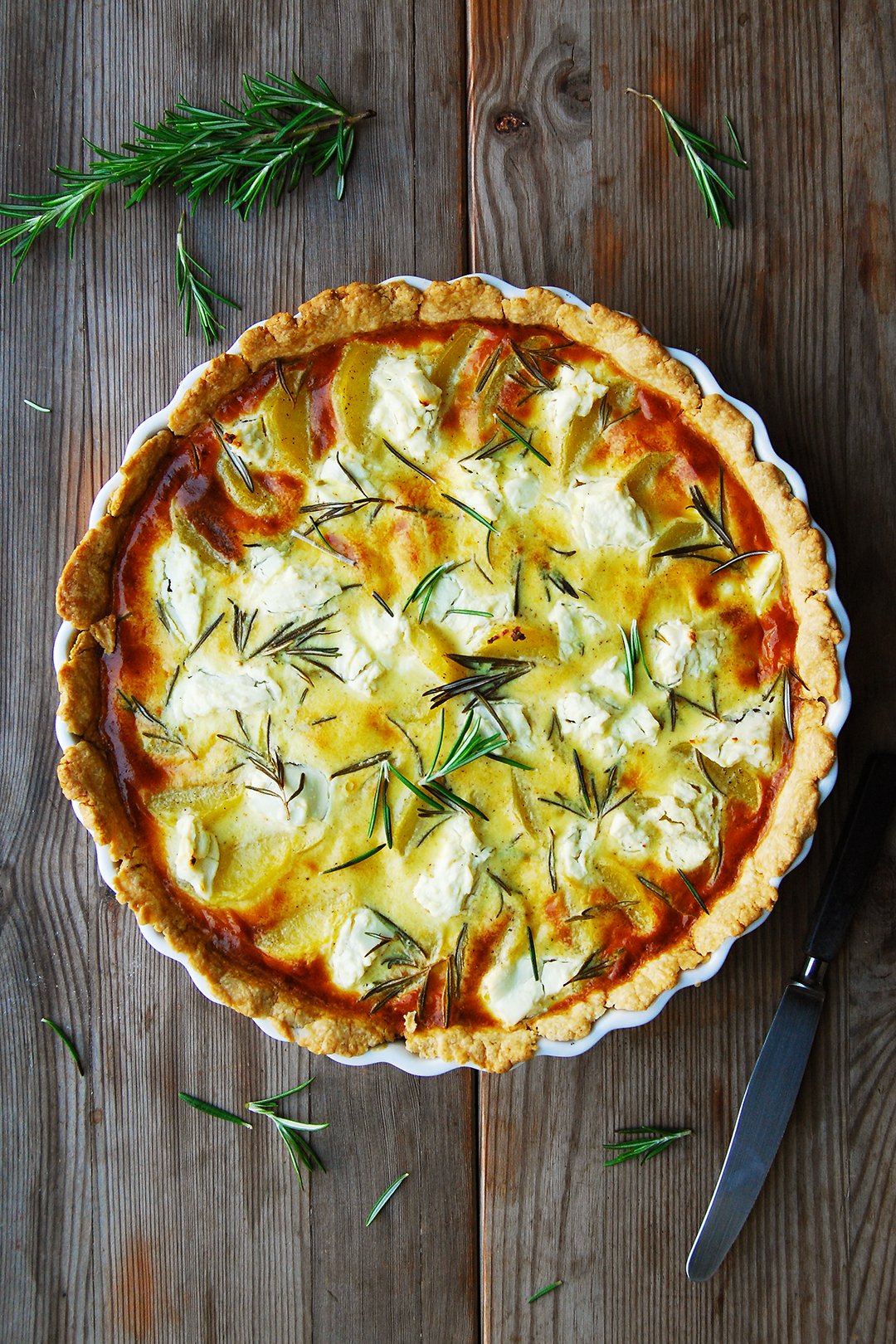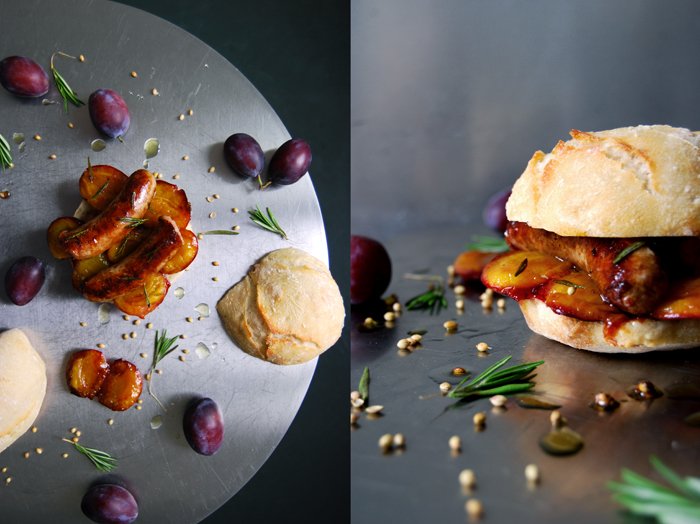Grilled Raclette with Rosemary Kumquats, Coriander Apple & Star Anise Pear
The light dimmed, tall candles casting flickering shadows on the ceiling, the room filled with the dry heat from the crackling fireplace and the smell of burnt wood and cheese lying in the air like a heavy cloud. When it's time for Raclette at my mother's house in the countryside, it's a celebration of everything that I connect with coziness. Surrounded by family and friends, everybody gathers around the sizzling Raclette grill to watch the magic happen: aromatic cheese melting and dripping, golden bubbles bursting and splashing as they touch the glowing grill, and the rind turning into smokey charred bites.
When you eat Raclette at a snow covered hut in the mountains, you would most likely enjoy it the classic way, with boiled potatoes, raw spring onions, pickled vegetables like gherkins (cornichons) and pearl onions, and lots of crushed or coarsely ground black peppercorns. The cheese needs added acidity, which can come from the pickles but it can also come from fruit.
So here's the fruity way to enjoy the fragrant melted cheese on a crusty baguette: I skip the pickles and go for Raclette with rosemary kumquats, coriander apple, and star anise pear. Kumquats cooked with honey and fresh rosemary turn the tiny citrus fruits into soft and caramelized bites. Pear wedges seared in star anise butter taste like Christmas and apple wedges softened in coriander butter are sweet, aromatic, and slightly sour. That's the colorful trio to complete my rustic Raclette table but you could also add roasted grapes or plums, or juicy persimmons. Whatever fruit you would normally eat with cheese will fit; it can only become better with a little heat, either in the pan on the hob or under the grill. The heat softens the fruit's texture and makes the flavor even more concentrated. I would keep the side dish simple, you can serve the grilled Raclette with a quick green salad.
My mother always uses a very old Swiss made grill that's rather large. It can hold half a wheel of Raclette, melting the surface where the cheese is cut in half, and then you scrape the melted layer right off the wheel onto your plate. It's a lot of fun, but it's heavy, you need a lot of people to eat up half a wheel of cheese, and you can only feed the hungry crowd in batches - around two people every time you scrape the top layer off, then the half-wheel needs to go under the grill again. This is not necessarily a bad thing seeing as we're talking about a meal that's rather rich and filling. A break once in a while doesn't harm the hungry cheese lover, but if I want to throw a cozy Raclette party just for two (or maybe a couple friends), I go for my more practical tabletop grill with single Raclette dishes instead. Then I opt for sliced cheese and grab Le Rustique's Raclette l'Originale. It's aromatic yet not overpowering and melts like butter. When I use sliced cheese I remove the rind, and if you're after that smokey burnt touch you can just leave the Raclette on a little longer until the charred bubbles burst under the grill.
Thanks to Le Rustique for sponsoring this post and reminding me of the coziest celebration of cheese: watching - and eating - bubbling and crackling Raclette.
Grilled Raclette with Rosemary Kumquats, Coriander Apple and Star Anise Pear
You'll need a Raclette grill for this recipe.
Serves 3 to 4
For the fruit
2 tablespoons honey
2 tablespoons fresh rosemary needles (whole needles, not chopped)
12 fresh organic kumquats (or canned kumquats, drained), cut in half lengthwise and seeds removed
4 tablespoons freshly squeezed orange juice
Unsalted butter, to cook the pear and apple
3 star anise
1 large, firm pear, cored and cut into thin wedges
2 teaspoons coriander seeds, crushed with a mortar and pestle
1 large baking apple, cored and cut into thin wedges
For serving
About 500-600g (18-21 ounces) sliced Raclette cheese (for a tabletop grill with single Raclette dishes), rind removed
1-2 crunchy baguettes, sliced
Crushed or coarsely ground black peppercorns
Optional
2 large handfuls mixed small leaf lettuce (young spinach and chard, mâche or corn lettuce)
Olive oil
Balsamic vinegar
Fine sea salt
Finely ground pepper
For the kumquats, in a small, heavy pan, heat the honey over high heat until bubbling. Add the rosemary, kumquats, and orange juice and cook, turning once, for 3-4 minutes or until golden brown and soft - mind that the kumquats don't burn. Set the pan aside and keep warm.
For the pear, in a medium, heavy pan, heat 2 tablespoons of butter and the star anise over medium-high heat until sizzling. Add the pear wedges and sauté, turning once, for about 3-4 minutes or until golden brown and tender. Set the pan aside and keep warm.
For the apple, in a medium, heavy pan, heat 2 tablespoons of butter and the coriander seeds over medium-high heat until sizzling. Add the apple wedges and sauté, turning once, for about 3-4 minutes or until golden brown and tender. Set the pan aside and keep warm.
Melt the cheese, one slice at a time, under the Raclette grill until bubbly then scrape onto a slice of baguette, top with kumquats, apple wedges, or pear wedges and season with crushed black pepper.
You can serve the grilled Raclette with a simple green salad on the side: Divide the mixed lettuce leaves among the plates, drizzle with a little olive oil and balsamic vinegar, and season to taste with salt and pepper.
Enjoy!
Roasted Grapes and Camembert Sandwich with Rosemary
My love for cheese is deep and passionate. I embrace the whole variety of soft and hard, young and old, of cow, goat, and sheep milk cheese without skipping a bite. However, I always had a particular pull towards the oldest, runniest, and strong-smelling examples.
In my late teenage years, I spent a romantic weekend in Paris. Aside from the usual sightseeing spots, the strolls through the stunning Louvre and Musée d'Orsay, long walks along the Seine and busy Boulevard Saint-Germain, I went straight for the city's boulangeries, pâtisseries, charcuteries, and fromageries. It was my first proper food trip, constantly carrying - and nibbling from - bags filled with baguette, croissants, pâté, tartes, éclair au café, and cheese. Whenever I spotted a bench or a park, I declared it my picnic zone and made it a moveable feast. It was summer and I bought so much cheese that I had to find a way to store all these rolls, rounds, and triangles. Our hotel room's mini bar seemed like the only suitable place to keep my fragrant treasures. Just as we left, as I collected my food and other belongings, I noticed a particularly strong odor of a very aged camembert escaping the tiny fridge. In that moment I pitied the future guests of our room, and it dawned on me that it would take days for it to recover from my visit.
Camembert always had a very special place in my heart. When it's young and firm, still a bit white and crumbly in the center, I enjoy it at breakfast on crunchy baguette. The flavour is mild and still developing. But when it's aged and so soft that it practically melts inside the white rind - my favourite - the cheese is at its tasty peak. Then it needs a glass of full-bodied Bordeaux, or ripe fruits or concentrated chutneys. Le Rustique manages to capture this quality of rich ripeness perfectly, the cheese is strong and creamy, packed with a sharp taste that makes it so special. So when the cheese makers from Normandy asked me to create a sandwich recipe for their famous round product wrapped in red gingham cloth, I knew it would need a potent partner. Grapes and cheese are a common couple, but when you roast the little fruits in the oven until they shrivel, their flavour concentrates beautifully. I balance their sweetness with fresh rosemary to add woody tones to a rather opulent sandwich of ripe camembert and roasted grapes.
Thanks to Le Rustique for sponsoring this post and reminding me of the little culinary adventures that I have in my life through one of my favourite treats: the wonderful world of cheese.
Roasted Grapes and Camembert Sandwich
Makes 2 sandwiches
300g / 2/3 pound seedless red grapes, on the vine
6 small sprigs fresh rosemary
Olive oil
Flaky sea salt
100g / 4 ounces aged, aromatic camembert, such as Le Rustique, cut into thick slices
2 rustic, white buns, cut in half
Preheat the oven to 220°C / 425°F.
Place the grapes and rosemary in a medium baking dish. Drizzle with 2 tablespoons of olive oil, gently toss to coat, and season to taste with salt. Roast for 30 to 35 minutes or until the grapes are soft and a little shriveled.
Divide the camembert among the bottom halves of the buns. Snip the grapes off the vine and arrange on top of the cheese and sprinkle with the roasted rosemary. Place the top on each bun and enjoy.
Peach, Chèvre and Rosemary Tart
I allowed myself a few treats during our Mediterranean summer in Malta. I went snorkeling far more often than in the past few years, when my cookbook determined my schedule, I had a few girly shopping moments, and my man and I relaxed at the stunning - and newly renovated - Phoenicia Hotel in Valletta. We enjoyed stunning views from their infinity pool with a glass of crisp Maltese wine close at hand and indulged in lush breakfast buffets and fine French inspired cuisine on their gorgeous terrace overlooking the gardens.
Malta treated us well, the Mediterranean pace and hot climate force me to slow and calm down, something I only truly manage there. Nothing feels as heavy, as worrying or threatening as it might feel anywhere else, everything feels manageable and enjoyable. It's not so much about duties, but about collecting and treasuring the good moments in life. This also reflects in my cooking. If I spent a couple more hours at the beach, we just cooked dinner a bit later, or kept it simple by throwing a fish on the grill and drizzling some fresh lemon juice over it. It's pure, it's good, and it allows me to have more time to chill and chat with a friend, to sit on the rocks a little longer and see the sun disappear into the sea's faded evening-blue.
Another one of my lazy summer recipes is this lovely little sweet and savoury tart: ripe peaches, soft chèvre and Mediterranean rosemary spread on top of (store-bought!) puff pastry. You could also make your own, or use short crust pastry, but my lazy self just went to the supermarket and bought frozen Maltese puff pastry - the best I know.
The tart turned out even better than expected, offer it to your friends who don't have a sweet tooth at teatime, or slice it up for a relaxed late summer dinner in the garden or on the balcony and pop open a bottle of wine. Heaven.
This recipe also works with grapes!
Peach, Chèvre and Rosemary Tart
Makes 1 (28cm / 11″) tart, serves 4-6
frozen puff pastry, defrosted, 320g / 11 ounces (you can also use short crust pastry)
large ripe peaches, cut into wedges, 4-5
mild soft chèvre, crumbled, about 150g / 5 ounces
fresh rosemary, finely chopped, 1 generous tablespoon
liquid honey 2 1/2 tablespoons
Preheat the oven to 200°C / 400°F and butter a 28cm / 11″ tart pan.
Line the tart pan with the puff pastry, pushing the pastry into the pan, and put in the freezer for 5 minutes.
Spread the peaches in a circle on top of the pastry, sprinkle with the chèvre and rosemary, and drizzle with the honey. Bake for about 35 minutes or until the pastry is golden brown and crisp at the edges (mind the heat, I use a gas oven in Malta, which is not as precise as my oven in Berlin).
Let it sit for about 10 minutes before serving and enjoy!
Lemon Butter Roast Chicken with Peaches and Rosemary
Roast poultry is always a feast. Nothing beats a whole roast chicken, the skin golden and crisp, the meat succulent and tender. And when it comes to seasoning the chubby bird, there are no rules to obey. Sweet or sour, fruity or veggie-focused, spiced-up or plain, a chicken can deal with everything. Lemon butter sounds fresh, tastes fresh, and turned my chicken into a perfect summer lunch. Italian peaches lend juice and fruitiness, a little sweet, but not too much, and rosemary brings in woody tones. Seeing as we're talking about feasting, there had to be wine on the table. The bird didn't necessarily need it, but my mood called for a German Riesling, chilled, fresh, and fruity.
If you love wine, here's a little experiment for the next time you open a bottle: choose a good bootle of white or red wine and pour it into three to five different wine glasses. You can also go for champagne, if you're in the mood for bubbles, but take your time and consciously taste the wine, its complex tones and colours, revealed by the dimensions of each glass, its shape, volume, height, and curves. If you have three glasses, you'll taste three variations of the same wine.
My mother - who loves wine at least as much as she loves food - introduced me to this kind of wine tasting in my early twenties. She has a huge crystal glass collection handmade by 260 year old glass maker Riedel, not only for white, red, and sparkling wine, but also for different regional wine and grapes. The taller Bordeaux glass, the rounder Burgundy that opens at the mouth, the elegantly shaped Syrah glass, they all bring out the best, the typical characteristics of these wines. That doesn't mean that a fine Chablis can't be enjoyed out of a glass that was made for a Riesling, but it might miss certain nuances that give it the final touch, the magic that goes beyond words.
After my first lesson in the art of wine glasses, I decided to follow my Mama's food steps and invest in a basic collection, my first machine-blown Riedel glasses. My budget was a bit more limited than my mother's, I focussed on shapes that work well for various grape varieties. Riedel's Rheingau glass, for example, is quite an allrounder, it flatters crisp and fruity whites like my beloved German Grauburgunder (pinot gris), but I also found out that a bubbly Crémant d'Alsace doesn't mind this shape either - in case a Champagne glass isn't at hand. When it comes to the reds, I'm a fan of body, weight, and depth. The classic Bordeaux shape goes quite well with a few of my favourite wines. These wine glasses were the start of my ever growing collection, which also led to ever growing kitchen shelves, but that's another story.
Falling for wine glasses is a passion, it makes sense once you start investing in finer wines. A glass collection grows and changes every year, like a wine collection, there will be losses and new additions. It's alive, like the wines that they're filled with. It's always sad to lose a precious glass, but it's also so exciting to see a new shape added to the shelf.
When Riedel asked me, if I'd like to try out their new Fatto A Mano range, handmade at their headquarters in Kufstein in the western Austrian province of Tyrol, I could already hear my mother's ecstatic voice. Fatto A Mano is a beautiful collection, thin and light at the top, tall and elegant, and it introduces a new feature. Inspired by the Venetian tradition of glass making, a coloured handmade stem is the base of each glass of this collection. The bowl, however, sitting on top, is machine-blown and then fused with the stem, a process developed by Riedel. The colour scheme, including bold yellow, red, blue, and green, and more minimal black and white, adds fun to the table. The art of wine making is a science, but the art of wine drinking is first and foremost a pleasure that allows us the luxury to relax and let go, to taste and just smile at life.
Setting up the table for a dinner party or a weekend lunch feast with friends - especially now, in summer - doesn't need to follow strict rules anymore. We play with the arrangement and mix and match tableware, colours, shapes, and materials. Whatever mood I'm in, the food I choose, but also the way I lay out my table, reflects how I feel. The table is the stage for the feast, where we gather with the ones we love to enjoy a few hours of good food and wine, of closeness and conversation.
Thank you, Riedel, for introducing me to your artful Fatto A Mano collection. It has already created quite a few hours of pleasure at our table - for me and my friends.
In the pictures you see the Riedel Riesling glasses from the new Fatto A Mano range, the stemless Viognier / Chardonnay glasses from The O Wine Tumbler collection, which I used for water, and the perfectly shaped round-bellied Marne wine decanter.
Lemon Butter Roast Chicken with Peaches and Rosemary
You can use leftover meat, sauce, and fruit to stir into warm pasta and sprinkle with fresh basil.
Serves 2-3
unsalted butter 60g / 4 tablespoons
freshly squeezed lemon juice 75ml / 1/3 cup
whole free-range or organic chicken, about 1.5kg / 3.3 pounds, 1
flaky sea salt
ground pepper
medium sprigs fresh rosemary 6
large lemon, cut into 8 wedges, 1
large, firm peaches, cut into 8 wedges each, 3
Preheat the oven to 190°C / 375°F (convection setting or Rotitherm setting, if available).
In a small sauce pan, melt the butter and pour into a medium baking dish, large enough to fit the chicken in. Whisk in the lemon juice, then transfer the chicken to the baking dish and toss in the lemon butter until coated on all sides. Season the chicken with salt and pepper inside and out and lay 2 sprigs of rosemary inside the chicken. Arrange the remaining rosemary, lemon and peach wedges around the bird. Roast, spooning the juices from the pan over the chicken every 15 minutes, for 45-55 minutes or until the juices run clear when you prick the thickest part of a chicken thigh with a skewer. Turn on the broiler (grill) for a few minutes or until the chicken skin starts sizzling, mind that it doesn't burn. Take the chicken out of the oven and let it rest for a few minutes.
Carve the chicken and serve with the peaches and baguette to dip into the juices - and with a glass of chilled Riesling of course.
If you're looking for a starter, or a dish to accompany the roast chicken for an easy lunch or brunch, try my leek, tomato, and thyme quiche or basil ricotta and tomato quiche.
A Summery Berry and Bacon Panzanella with Rosemary
A Tuscan Panzanella salad had been on my mind for weeks, I could clearly picture the colourful composition: Dark red cherries, crunchy bacon, crisp arugula (rucola), and chunks of spongy ciabatta dripping with olive oil and thick Balsamico vinegar and then sprinkled with woody rosemary. I was just waiting for the fruits to arrive at my Turkish vegetable shop around the corner.
Unfortunately, the day I planned to throw the salad together, my trusted vegetable man didn't have cherries and - what worried me even more - the weather was dull and grey. The first problem was easily solved, I replaced sweet cherries with even juicier strawberries, blueberries, and figs, which made the whole thing even more mushy and luscious. It tasted great, but the soggy look made it rather difficult to catch a pretty picture. Even more so as they just put scaffolding in front of my kitchen window, which means the light situation in this room is far from ideal.
In these moments I always know why I love food so much and why photography, sometimes, drives me crazy. Food either tastes good or it doesn't, of course it should look appetizing, but I believe what tastes good also looks good. But photography has its own rules and mysteries, to be able to capture a dish's yumminess in a picture, the conditions need to be right, especially the light. So please, when you look at the pictures in today's post, think of summery-sweet fruit juices, porky saltiness crisped in the pan, the freshness of green leaves, and the confidence of Mediterranean rosemary. Buon appetito!
Berry and Bacon Panzanella with Rosemary
Serves 2-4
For the dressing
olive oil 3 tablespoons
balsamic vinegar 1 tablespoon
white balsamic vinegar 1 tablespoon
fresh rosemary, very finely chopped, about 2 teaspoons
fine sea salt
ground pepper
For the Panzanella
olive oil
bacon 4 slices
arugula (rucola) or mixed lettuce leaves, torn, a large handful
ciabatta or rustic white loaf, cut into chunks, 2 large handfuls
strawberries, cut in half, a handful
blueberries, a handful
figs, quartered, 2
For the dressing, whisk all the ingredients together and season to taste with salt and pepper.
For the Panzanella, heat a small splash of olive oil in a heavy pan over medium-high heat. Add the bacon and cook for a few minutes on both sides until crispy and golden brown. Take the bacon out of the pan, let it cool for a few minutes, and break into large pieces.
In a large bowl, spread the greens and lay the chunks of bread on top. Arrange the fruits and bacon on top of the bread and pour the dressing all over the Panzanella. Serve immediately, preferably for lunch, accompanied by a glass of white or rosé wine, and think of your next holiday.
Beluga Lentils with Grilled Cherry Tomatoes, Orange and Rosemary
Spontaneous weekend trips are the best way to calm the weary mind after a busy week. I don't have to travel far, I don't even need to stay overnight, just a few hours in a nearby forest or at one of Berlin's beautiful lakes and I'm back on my feet.
My mother brought many wonderful things into my life. My love for food and cooking was definitely sparked by her own passion. She also fed my need for snuggly Sunday afternoons on the sofa. I sink in a pile of cushions and wrap myself in a cozy quilt, preferably listing to Prokofiev, and a plate of warm waffles on my lap. This used to be one of our favourite weekend rituals. Unfortunately, we haven't made waffles together in a while, but there's another tradition from my childhood days that she introduced me to, which both of us still hold dear. Mother and daughter grab their jackets, hop in the car to find a nice spot in the countryside, and go on a short weekend adventure. We prefer relaxed walks that allow us to chat a little and enjoy the scenery around us. In all these years we must have walked hundreds of kilometres. We walked down narrow paths meandering through the darkest woods, jumped over tinkling waters, and crossed the fields on windy hill tops, where the sky feels endless and the views take your breath away. Mud, rain, heat, or darkness never stopped us from our next adventure.
When Volkswagen asked me for a new recipe, I had to think of one of my favourite places in Berlin for long walks, the gorgeous Müggelsee Lake. Be it spring, summer, autumn, or winter, this lake is a quiet beauty in every season. It's a peaceful place, my beloved weekend get away. Usually, we go to the local bakery and butcher and grab some sweets and a sausage. But this time I had another idea: wrapped in scarves, wool beanie, and a big jacket, sitting on a bench at the lake, we can have a little picnic date, even in winter. I went for a recipe that tastes just as good as a warm lunch and as a cold salad: nutty beluga lentils with sweet and smokey grilled cherry tomatoes and woody rosemary oil. It's a scrumptious trilogy.
Beluga Lentils with Grilled Cherry Tomatoes, Orange and Rosemary Oil
Serves 4
For the lentils
beluga lentils (no soaking required) 280g / 10 ounces
fresh thyme 1 small bunch
fresh rosemary 1 sprig
bay leaf 1
fresh orange peel 4 long strips
balsamic vinegar 1 tablespoon
fine sea salt
ground pepper
For the grilled tomatoes
cherry tomatoes, on the vine, 20
For the rosemary oil
olive oil 6 tablespoons
fresh rosemary, needles only, 4 sprigs
For the topping
freshly grated orange zest, about 1 tablespoon
Preheat the oven to grill / broil (quicker method) or preheat to 220°C (425°F).
Place the lentils in a saucepan with plenty of (unsalted) water, add the thyme, rosemary, bay leaf, and orange peel and bring to the boil. Simmer for about 20 minutes or until al dente (or follow the package instructions). Remove any excess liquid with a ladle, if necessary, and the spices. Stir in the vinegar and season with salt, pepper, and additional vinegar to taste.
Place the tomatoes in a baking dish and grill / broil for about 12 minutes or roast at 220°C / 425°F for about 35 to 45 minutes—their skins should start to burst and turn partly black. Leaving the tomatoes on the vine, divide them into 4 portions.
For the rosemary oil, in a small saucepan, heat the olive oil over medium-high heat. Add the rosemary and, as soon as it starts to sizzle, remove the pan from the heat. Cover and let the herb infuse the oil for at least 1 to 2 minutes. Remove the rosemary from the oil and set aside.
Stir the rosemary oil into the lentils and divide between plates. Arrange the grilled tomatoes and rosemary on top and season with fresh orange zest to taste. Enjoy warm or cold.
Blood Orange and Rosemary Upside Down Cake
I already had my post written for today's bright orange Sunday cake, but then, yesterday's news from the US hit me. It felt so wrong to just write about a recipe, my mood, my day; why should I write about me and my food, when on the other side of the Atlantic, a single man throws everything away that our so called civilized world claims to stand for. How can we, or the president of the United States, ban citizens from certain countries (Iraq, Iran, Yemen, Libya, Somalia, Sudan, Syria) from putting their feet onto American ground?
I'm German, my country's history shows what happens when we tolerate and support the insane actions of a single man. Didn't we learn anything? Is it still possible for us to allow a man to run a country who doesn't show the slightest feeling of compassion? Didn't we, in the western world, hypocrites, arrogantly accuse other countries of exactly that?
Before I was sad, now I'm concerned.
And yes, I baked a cake. It's an upside down cake - for an upside down world - made with Sicilian blood oranges. It looks like a glowing Mediterranean sunset, peaceful. Some prefer to cut off the citrus fruits' peel, I leave mine on for a tangy touch. I first sliced and then cooked three fruits in sugar water with a sprig of fresh rosemary to infuse the pulp. About half an hour later they were soft, ready to become the fruity base of a light and fluffy upside down cake, thanks to beaten egg white folded into the batter. The citrus is very present, which I like, the herbal note is subtle. If you prefer you can use less fruits, but I recommend creating a thick juicy layer of orange slices. They keep the cake wonderfully moist and fruity, also on the second day.
Blood Orange and Rosemary Upside Down Cake
Makes 1 (20 1/2cm / 8") cake
For the oranges
water 120ml / 1/2 cup
granulated sugar 100g / 1/2 cup
organic blood oranges, rinsed, scrubbed, and the ends cut off, 3
medium sprig of rosemary 1, plus a few needles finely chopped (optional)
For the dough
plain flour 200g / 1 1/2 cups
baking powder 2 teaspoons
butter, at room temperature, 80g / 1/3 cup
granulated sugar 150g / 3/4 cup
organic eggs, separated, 2
vanilla pod, split and scraped, 1/2
milk 100ml / 1/3 cup plus 1 tablespoon
fine sea salt 1/8 teaspoon
Preheat the oven to 180°C / 350°F. Butter and line a 20 1/2cm / 8"springform pan.
For the oranges, in a large saucepan, bring the water and sugar to a boil over medium high heat. Stir and let the sugar dissolve. Cut the oranges into thin slices. Reduce the heat to medium, layer the orange slices in the sugar water, and simmer gently for about 25-30 minutes or until soft, but still in shape. Using a slotted ladle, transfer the orange slices to a large plate and let them cool for a few minutes. Add the rosemary to the pot with the orange syrup and set aside.
For the dough, in a medium bowl, combine the flour and baking powder. In a large bowl of a stand mixer, beat the butter and sugar until light and fluffy. Add the egg yolks and vanilla seeds and continue mixing for about 1 minute or until well combined. Quickly beat in the flour mixture in 3 batches, alternating with the milk. Beat the egg white and salt until soft peaks form and fold into the dough.
Arrange the orange slices on the bottom and sides of the prepared pan, fold some of the slices into the corners (see 2nd picture). Scrape the dough on top of the fruits, even it out and bake for about 35-40 minutes or until golden brown and spongy. Check with a skewer, it should come out clean. Let the cake cool for a few minutes before you flip it over, gently remove the parchment paper.
Bring the rosemary orange syrup to a boil over high heat and let it cook for about 2 minutes, let it cool for a couple minutes. Brush the top of the cake with the syrup and arrange the rosemary sprig on top. Sprinkle with a little additional chopped rosemary and enjoy!
Pear and Blue Cheese Tart from my cookbook and a picnic in Valletta
Malta, October 2016:
The sky was blue and October's sun still hot, it was a glorious Saturday morning when I met my friends in Msida. The air was filled with the usual chatting and laughing before we hopped into our cars to drive up to Valletta. We brought along the obligatory guitar and our picnic baskets packed with sandwiches, fruits, and a buttery pear and Stilton tart sprinkled with rosemary - a popular recipe from my Eat In My Kitchen book. And off we went to Malta's capital.
We had planned this day trip weeks in advance: to have a picnic in Valletta, high up on the bastions opposite The Three Cities, to park Michelangelo's beautiful Volkswagen beetle in the shade of one of the old olive trees, and set up a little table right next to this cute blue beauty on wheels. It was a luscious brunch in the most stunning surroundings and to bake a savory tart was the best choice for this occasion. You can prepare it in advance, it's delicious even when it's cold, and it fits perfectly to chilled sparkling wine. The topping is minimal, but the combination of baked pear, melted Stilton, and roasted rosemary is so good that it became one of my favorite recipes this year. The creation almost didn't make it into my book. I had a different tart in mind but I couldn't find a certain vegetable on the day of the shoot and spontaneously decided that I could also just fill the pastry with fruit, cheese, and herbs. It was a wise choice that I don't regret.
The setting was as spectacular as our nibbles. If you ever visit Valletta, you have to go to the St. Barbara Bastion and enjoy the breathtaking view overlooking the Grand Harbour and The Three Cities, Vittoriosa, Cospicua and Senglea. Then walk down to the Valletta Waterfront and take one of the little ferries to Cospicua. It only takes a few minutes and it allows you to enjoy two of the most stunning places in Malta, on land and from the sea: the golden beauty Valletta and the three fortified cities.
Pear and Blue Cheese Tart with Rosemary
From my first cookbook, Eat In My Kitchen
Serves 4 to 8
For the pastry
2 cups (260 g) all-purpose flour
1 teaspoon fine sea salt
½ cup plus 1 tablespoon (130 g) unsalted butter, cold
1 large egg
For the topping
2 large, firm pears, cut into thin wedges
3 ounces (85 g) aromatic blue cheese, such as Stilton, Roquefort, Fourme d'Ambert or Gorgonzola, crumbled
3 medium sprigs fresh rosemary, needles only
3 tablespoons olive oil
Flaky sea salt
A few black peppercorns, crushed with a mortar and pestle
For the pastry, combine the flour and salt in a large bowl. Add the butter and use a knife to cut it into the flour until there are just small pieces left. Quickly rub the butter into the flour with your fingers until combined. Add the egg and mix with the dough hooks of an electric mixer until crumbly. Form the dough into a thick disc, wrap it in plastic wrap, and freeze for 10 minutes.
Preheat the oven to 400°F (200°C).
On a table or countertop, place the dough between 2 sheets of plastic wrap and use a rolling pin to roll out into a disc, large enough to line the bottom and sides of a 12-inch (30 cm) quiche dish. Fit the dough into the quiche dish, pushing it into the dish, especially along the edges. Let the dough hang over the rim a little or cut it off with a knife. Use a fork to prick the dough all over. Bake for 15 to 18 minutes or until golden. If the dough bubbles up, push it down with a fork. (If you blind bake the pastry under parchment paper and dried legumes, remove the paper and legumes after 15 minutes and bake uncovered for a few more minutes until golden.)
Arrange the pear wedges in overlapping circles on top of the warm, pre-baked pastry, sprinkle with the cheese and most of the rosemary, drizzle with the olive oil, and season to taste with flaky sea salt and crushed peppercorns. Bake for 15 minutes or until the cheese has melted and the pastry is crisp. Sprinkle with the remaining rosemary and enjoy warm or cold.
Eat In My Kitchen is out! From the book: Radicchio, Peach & Shallot with Stilton
The Eat In My Kitchen book is out and I'm the happiest person on the planet!
One of the exciting - and often quite challenging - things in life is that you never really know where the journey will take you. It's like being on a ship out on the open sea. Sometimes it seems like you can control the direction, but it might just be an illusion, and in the end you can only ever go with flow instead of fighting against it. Since I understood this, my life rolls more smoothly than ever. I wasn't one of those kids that had a clear idea of their future and what it should bring. At the age of 18 I was still a bit clueless about my place in this world, so I decided to go to university and study architecture. I was a good girl and left 4 years later with a diploma in my pocket although I knew I wouldn't want to work as an architect. Instead, I worked happily in the music industry for 15 years. But things changed, I changed, the music business changed, my direction in life changed. I decided to start a food blog on a cold winter's day in November 2013, and this decision had more of an impact on my life than I could have imagined back then. I shared a new recipe every day in the first year of Eat In My Kitchen, and although I felt creatively extremely stimulated after those 12 months, I was also exhausted. My writing and photography improved tremendously in that year, and my cooking and baking evolved as well - I became more experimental. However, I had to slow down the pace, it was too much. But the solution was easy: less posts on the blog and I found a rhythm that allowed me to enjoy every single part of being a blogger (it still feels weird to say that).
In the even colder days of February 2015, life, the universe, destiny, luck, or whatever you may call it, had different plans. Holly La Due from Prestel Publishing in New York came into my life, she sent me an email in the morning, we skyped in the afternoon, and sealed our deal in the evening - all in one day. Holly's decision to ask me if I'd like to write a cookbook, changed my life so drastically that I'm still processing what's been happening in the past year and a half. I never really got used to seeing myself as a blogger, life was too fast, and now I'm a cookbook author. I still have these moments, when I look at my book using one of the recipes in my own kitchen, and I get a little shock and feel, "wow, that's my book". I guess I need a little more time.
Most of the time in life it's not just us alone, not just a single person who creates, we're woven into a net of people, ideas, and visions. Whoever pulls the string on one side of the net, affects the whole result. This heavy blue book full of recipes, Eat In My Kitchen - to cook, to bake, to eat, and to treat, is not just lying on my table anymore, today it's been sent out into the world, now it's on the book shelves and maybe lying on your table. And this makes me feel peacefully happy and thankful, I could squeeze the world.
This book has been a gift for me from the start. Being able to turn a vision into a physical object makes me feel very humble, I know that this book carries a part of every single person who's been involved. Thank you, to the most amazing team and friends all over the world:
Holly, Jamie, Jan, Lauren, Karen, Luke, Stephen, Angy, Emma, Oliver, Andrew, Will, Marisa, Ron, Monica, Ellen S, Jen, Pia, Julie, Adeline, Ellen M, Cynthia, Molly, Malin, Yossy, the Cini family, Jasmine and Melissa Hemsley, Joanna, Karl, Jo, Iggy, Marina, Türkan, Jörg, Kitty, Hetty, Mama, Uli, Ursula, Uwe, Jenny, Edith, Emma, Alex, Julia, Nina, Kim, Jessica, Luke, Matt, Muxu, Daphne, Nadine, Jan, Essa, Sandra, Chris, Alexandra, Doris, Chris, Anna, Jimmy, Gina, Pattie, Jayne, and all my loved ones.
Thank you my wonderful food loving blog friends, you've come back and visited these pages for almost 3 years. Your passion, enthusiasm, your questions and comments, your emails and pictures, made me enjoy my kitchen and my food even more than I already do. You drive me on to dig deeper into culinary traditions and to come up with new ideas every day. Thank you and a big hug!
Today I'll share the second recipe from my book with you, the colourful salad that made it onto the cover of my book and that became one of my favourites. It's a luscious composition playing with contrasts: bitter crunchy radicchio, soft and juicy peaches, sweet oven roasted shallots, sharp Stilton, and a little thyme. It's a beauty on your picnic blanket, a fresh addition to your brunch table, and the easiest starter for a dinner party.
The pictures of me and the picnic scene in this post were taken in July, at Villa Bologna in Malta, for an article in Eating & Drinking Magazine.
Radicchio, Peach, and Roasted Shallot Salad with Blue Cheese
SERVES 2 TO 4
FOR THE SALAD
8 shallots, peeled and cut in half lengthwise (or 4 small red onions, peeled and cut into quarters)
2 tablespoons olive oil
Flaky sea salt
Ground pepper
5 ounces (140 g) radicchio, soft leaves only, torn into pieces
4 ripe peaches, peeled and cut into 8 wedges each
2 ounces (60 g) Fourme d’Ambert, Stilton, or any crumbly blue cheese, crumbled
1 to 2 tablespoons fresh thyme leaves
FOR THE DRESSING
3 tablespoons olive oil
1 tablespoon balsamic vinegar
1 tablespoon white balsamic vinegar
1 teaspoon honey
Fine sea salt
Ground pepper
Preheat the oven to 425°F (220°C) and line a baking sheet with parchment paper.
Spread the shallots on the lined baking sheet, drizzle with the olive oil, and season to taste with flaky sea salt and pepper. Gently mix with your fingers and roast for 10 minutes. Flip the shallots over and roast for another 5 minutes or until golden brown and soft. Peel any hard or burnt layers off the shallots and set them aside. You can prepare the shallots in advance; they don’t need to be warm.
For the dressing, whisk together the olive oil, both vinegars, and the honey; season to taste with salt and pepper.
Arrange the radicchio, peaches, and shallots in overlapping layers on plates, sprinkle with the crumbled cheese and thyme, drizzle with the dressing, and serve immediately.
Fig, Chèvre and Honey Focaccia with Rosemary
My kitchen in Berlin faces a quiet backyard. In summer, I love to leave the windows wide open, hear the birds sing, and then it's often just me, alone with my thoughts and ideas, imagining ingredients, remembering old classics or coming up with new recipes. I get the cooker or oven started and my meditation begins: I just cook in silence.
Seeing that the weather hasn't shown the slightest hint of summer, I concentrated on rather hearty pleasures. I made cheese spaetzle (Southern German egg noodles with lots of melted cheese and golden onions), pasta with sautéed radicchio, chicken liver, and mustard butter, and enjoyed my obligatory Sunday pizza night. I also tried out a new cake recipe with the sweetest greengage plums, which was great, and I experimented with some dip variations. It was all very relaxing, calming, and put my mind at ease.
I also pulled one glorious - and much appreciated - dish out of my oven that combines all the fun of summer: a spongy, oily focaccia topped with ripe figs, soft chèvre, honey, and rosemary. It's perfect for breakfast, lunch, dinner or for a picnic - I could even have it at teatime with a cup of Darjeeling.
Fig, Chèvre and Honey Focaccia with Rosemary
Makes a 25 x 32cm / 10 x 12 1/2″ focaccia
For the dough
plain flour 500g / 3 3/4 cups plus 2 tablespoons
fast-acting yeast 1 (7g / 1/4 ounce) envelope
fine sea salt 1 teaspoon
granulated sugar 1 heaping teaspoon
water, lukewarm, 260ml / 1 cup and 2 tablespoons
olive oil 120ml / 1/2 cup, plus 1-2 tablespoons to oil the baking sheet
For the topping
honey 2 tablespoons
ripe figs, cut in half, 6
soft chèvre, torn into pieces, 150g / 5 ounces
fresh rosemary needles, a small handful
flaky sea salt
black peppercorns, crushed in a mortar (optional)
For the dough, combine the flour, yeast, salt, and sugar in the bowl of a stand mixer fitted with the dough hook. Add the lukewarm water and half the olive oil (60ml / 1/4 cup) and knead on medium-high speed for a few minutes until well combined. I mix it on '4' on my KitchenAid. If the dough is too sticky, add more flour. Transfer the dough to a table or countertop and continue kneading and punching it down with your hands for about 4 minutes or until you have a smooth and elastic ball of dough. Place the dough back in the mixer bowl, cover with a tea towel, and let rise in a warm place, or preferably in a 35°C / 100°F warm oven (conventional setting), for about 60 minutes or until doubled in size.
Oil a 25 x 32cm / 10 x 12 1/2″ baking sheet.
When the dough has doubled in size, punch it down, take it out of the bowl, and knead for 1 minute. Using your hands, stretch and spread the dough on the oiled baking sheet. Cover with a tea towel and let rise in a warm place for about 20 minutes or until puffy.
Preheat the oven to 220°C / 425°F (convection setting). Heat the honey in a saucepan over low heat for about 1 minute or until liquid.
Using the round bottom of a wooden spoon or your finger, punch around 6 x 7 holes into the surface of the dough. Pour the remaining olive oil over the dough and into the holes. Spread the figs (cut side up) over the focaccia and push them gently into the dough. Sprinkle with the chèvre, rosemary, and a little flaky sea salt, and drizzle with the warm honey. Bake for 20 minutes or until golden and light brown. Sprinkle with crushed pepper and enjoy warm or cold.
A juicy Grape and Rosemary Tart
This tart combines two of my favourite Mediterranean flavours - grapes and rosemary - and the result is nothing less than heavenly. The fact that the aromatic filling lies on top of buttery crisp puff pastry only exaggerates the temptation.
After failing miserably at making my own puff pastry on a few occasions, I only use this sweet delicacy when I'm in Malta, when I can buy it frozen in exceptionally good quality. If I ever manage to come up with a recipe that's as good as the product that I can buy here from the supermarket, I'll be a very happy baker. You could also use a shortcrust base for this summery tart but I like the elegant look and flaky texture of puff pastry in combination with the syrupy, juicy grapes. The chopped fresh rosemary sprinkled on top of the warm cake as soon as it comes out of the oven adds a woody aroma and gives it an unusual touch - try it, it's fantastic. I used it for a focaccia recipe last year and got hooked on this tasty duo.
I've already baked this tart twice since we arrived in Malta and it immediately gained huge popularity within our family - everybody loves it, kids and grandmother included!
Grape and Rosemary Tart
Makes 1 (28cm / 11") tart, serves 4-6
frozen puff pastry, defrosted, 320g / 11 ounces
dark grapes, preferably seedless, 500g / 18 ounces
granulated sugar 120g / 2/3 cup
freshly squeezed lemon juice 1 tablespoon
roughly chopped fresh rosemary 1 generous tablespoon
Preheat the oven to 200°C / 400°F and butter a 28cm / 11" tart pan.
Line the tart pan with the puff pastry, pushing the pastry into the pan, and put in the freezer for 5 minutes.
In a large bowl, using a large spoon, mix the grapes, sugar, and lemon juice and spread on top of the chilled pastry. Bake for about 40-45 minutes or until the pastry is golden brown and crisp at the edges. The grapes will be juicy, so the bottom of the tart won't be crisp. Sprinkle the tart with the rosemary and let it sit for about 10 minutes before serving.
Beluga Lentils with Ginger Orange Rutabaga and Rosemary
I once read that the 3rd Monday of January is supposed to be the most depressing day of the year - Blue Monday. I don't know if it's true, luckily it has already passed, and I didn't notice my mood drooping drastically that day. However, I've felt a rising impatience for more light and warmer weather to come back into my life. So much so that I had to book flights to Malta last night. This always makes me feel so much better, no matter how far in the future the departure date lies, just the thought of it puts me in a good mood.
Another way to lift my spirits is food. Cosy food, colourful food, or simply delicious food. This dish combines all of it: nutty Beluga lentils, topped with thin slices of rutabaga, quickly cooked in the pan with lots of ginger, orange zest and juice, and fresh rosemary. The rustic root is as bright as the sunrise over Malta's east coast and its earthy flavour can easily deal with some strong aromas. I was surprised how well it merged with the dark legumes.
Beluga Lentils with Ginger Orange Rutabaga and Rosemary
Serves 3-4
For the lentils
Beluga lentils, or any lentils (no soaking required), 280 g / 10 ounces
small sprig fresh rosemary 1
bay leaf 1
olive oil
balsamic vinegar 1 tablespoon
fine sea salt
ground pepper
For the rutabaga
peeled rutabaga, cut into wedges and very thinly sliced (use a mandoline or cheese slicer), 300g / 10 1/2 ounces
freshly grated ginger 1 tablespoon
freshly grated zest of 1 orange
freshly squeezed orange juice 100ml / 1/3 cup plus 2 tablespoons
fine sea saltground pepper
finely chopped fresh rosemary needles 1-2 tablespoons
black peppercorns, crushed in a mortar
Place the lentils in a saucepan with plenty of (unsalted) water, add the rosemary and bay leaf, and bring to the boil. Simmer for about 20 minutes or until al dente (or follow the package instructions). Remove excess liquid with a ladle if necessary and stir in a generous splash of olive oil and the vinegar. Season to taste with salt, pepper and vinegar.
While the lentils are cooking, prepare the rutabaga: In a large, heavy pan, heat a generous splash of olive oil over medium-high heat. Add the rutabaga and cook for about 5 minutes, stirring occasionally, until golden and al dente. Scrape the rutabaga to the side, add a little more olive oil to the pan along with the ginger, cook for 1 minute, stirring constantly. Add the orange zest (leave a little of the zest for the topping) and juice and season with salt and pepper. Stir in the rosemary or use as a topping once the plates are ready. Cook for another 1-2 minutes until the desired texture is reached.
Divide the lentils between plates and lay the rutabaga on top. Sprinkle with rosemary, orange zest, and crushed peppercorns and drizzle with a little olive oil (optional). Serve immediately.
meet in your kitchen | London: Jo Rodgers' Chocolate, Hazelnut, and Rosemary Pie
Jo's hands, an open book on a wooden table, and a cup of tea are the reason for this meet in your kitchen feature. A few months ago, I came across the Instagram account of this gorgeous American woman living in London and since then, I basically follow her activities every day. There is a kind of peace in her pictures that struck me immediately. In the beginning, her images often showed her hands turning the pages of her current favourite book surrounded by snacks and nibbles and a cup of warming hot chocolate or tea, or a glass of wine. And all this accompanied by her beautiful words describing the scene in her cosy cottage in the heart of London. Jo used to work as an editor at Random House and a literary agent at WME but, since she became a writer for Vogue a few months ago, her little Instagram stories shifted from books to exciting trips to the English seaside, the Provence, the English countryside, and - my favourite - a luxurious railway journey with the Belmond Royal Scotsman through Scotland. When she also started writing about cosy treats such as the perfect omelet, stuffed pumpkin, cranberry muffins, and mince pies, I knew I had to meet this woman during my stay in London a couple weeks ago.
Where shall I start, we planned to bake a pie together but I was late and London's light is not very forgiving. To avoid shooting this sweet beauty in the dark, her husband Andrew was so kind to take all the pictures of the pie. Thank you so much for that! In the end, the two of us didn't spend much time in the kitchen, instead we spent four hours chatting, drinking tea, eating delicious chocolate chip cookies baked by her husband (the poor guy must pray that I'm not coming back soon seeing how much work I caused him!), and we finished our afternoon with a walk through Belgravia. I call it her village, Jo showed me William Curly's fantastic chocolate shop/ patisserie, the Poilane bakery on Elizabeth Street, her butcher, flower shop, her pub and favourite restaurants. After an hour of strolling around with her, I could have moved to this quiet - not very London-like - neighbourhood.
Besides having a wonderful girls afternoon, I can say that I found a friend. Jo and I had never met in real life but as soon as the fair blond woman opened the iron gate that leads to the yard in front of her navy blue door, it felt like we'd known each other for years. Jo is very calm and humble and has an honest kindness that comes straight from her heart. Her life is extremely interesting and it's so exciting to hear about it, although she herself wouldn't agree on that. She lived in Australia, Chicago, Boston, New York City, and since 2010, London. Jo studied 19th century British literature and would love to write a novel one day if her busy life would offer a little more free time. She has a beautiful way of playing with words, which makes them flow like a smooth river. Reading her articles is fun, so much so that I can't wait to hold her book in my hands one day. So we made a deal, from now on I will start bugging her and asking her every few months if she started working on it.
Jo shares her delicious pie recipe with us: a rich, buttery Chocolate, Hazelnut, and Rosemary Pie - she calls it a grown-up pie!
You can read all of Jo's articles for the American Vogue here.
Jo Rodgers' Chocolate, Hazelnut, and Rosemary Pie
For the pie crust
plain flour 200g / 1 1/2 cups
salt 1/4 teaspoon
cold butter, diced 115g / 1/2 cup
cold water 60ml / 1/4 cup
milk 1 tablespoon
For the filling
hazelnuts (whole) 100g / 3/4 cup
eggs, lightly beaten, 3
light corn syrup 180ml / 3/4 cup
sugar 200g / 1 cup
melted unsalted butter 115g / 1/2 cup
salt 1/2 teaspoon
vanilla extract 1 teaspoon
chopped fresh rosemary 2 tablespoons
dark chocolate, chopped, 170g / 6 ounces
1 sprig of fresh rosemary, for the top of the pie
On a flat work surface, combine the flour and salt, then incorporate the cold diced butter with your fingers. Rub the butter into the flour until the butter pieces are no larger than the size of peas. Make a well in the center of the flour, and pour in the cold water. Using your hands, mix the water into the flour until dough is formed. Wrap the dough in plastic and put in the refrigerator for one hour.
Preheat your oven to 175 °C / 350°F.
Toast the hazelnuts in the oven until they begin to get fragrant, about 7 minutes. Let the hazelnuts cool, then rub off the skins; you can do this with your fingers or a cloth towel.
Roll out the dough wider than your pie mold (there should be plenty of dough for any size or shape of pie mold; mine is quite deep, and there is still quite a bit of dough left over). Gently lay the dough into the mold and trim the overhanging dough with a sharp knife. Put the pie mold back in the refrigerator while you make the filling.
In a medium-sized bowl, combine eggs, corn syrup, sugar, melted butter, salt, and vanilla extract. Stir in the chopped rosemary.
Take the pie mold out of the refrigerator, and brush the edges of the dough with milk. This will help the pie to brown nicely.
Spread the chopped chocolate evenly over the bottom of the pie. Pour the filling over the chocolate. Arrange the hazelnuts in concentric circles on top of the filling. Place the single sprig of rosemary in the center of the pie.
Bake for 50 minutes, until the pie is browned and bubbling. Remove from the oven and let cool for one hour before serving. Serve with a dollop of mascarpone or crème fraîche.
You moved from New York City to London nearly six years ago, and decided to stay. What do you love about this city and your life here? What turns a place into a home?
I love New York, but I think that London is the best city in the world. When I’m away for too long I get homesick, and when I see it again from the airplane my pulse jumps.A sense of community is what turns a place into a home. Neighbors you bump into at the bakery, friends you have over for supper. We have lived in one small area of London for the time we have been here, so we have been walking to the same florist, farmer’s market, chocolate shop, and so on for the duration. It is a comfort to know a place well, even if it is just your neighborhood.
What do you miss about America?
Our friends and family who live there.
You graduated from Wellesley College, an all-women’s university in Massachusetts, where you studied Victorian literature. What was it like being at Wellesley, and what drew you to your subject?
I was head over heels for Wellesley. Other than my husband, all of my closest friends are women. The strength of those relationships is due in part, I’m sure, to an education that placed the highest value on supporting other women.I was drawn to nineteenth century literature because I love novels, and that period was the heyday of the novel. I remember sitting in my dorm room with the windows open, curled in a chair with a piece of toast and Middlemarch (or The Woman in White, or Bleak House) and thinking—well this is heaven.
As a travel journalist, you get to see the most beautiful places. Which of your recent trips struck you the most?
I had a really wonderful time on the Royal Scotsman, a five-day train journey through Scotland. Having a whisky while watching the highlands go by is very difficult to top. The trip also begins and ends in one of my favorite cities, Edinburgh.
You were an editor for Random House in New York and then a literary agent at WME in London, where you worked with lots of fantastic cookbook authors. What did you love about working on books about food?
I have always been a great eater as well as a reader, so working on a few cookery titles as well as novels seemed like a natural fit. The company of other people who love to cook and eat is always such a pleasure.
How do you develop new recipes when you are writing for Vogue?
Slowly. I generally begin with a dish I know very well, consider whether there is anything that could be improved, and then stress-test the recipe for consistency quite a few times before it goes to print. I did a piece on cranberry muffins recently, and the whole neighborhood was eating cranberry muffins for a month.
What was the first dish you cooked on your own, what is your first cooking memory?
Sugar cookies from The Joy of Cooking. I lost my head in the spice cabinet (Curry? Nigella? Why not) and left a huge, inedible mess. My mother was not pleased.
What are your favourite places to buy and enjoy food in London?
We do the majority of our shopping within a few minutes walk of where we live. Daylesford for most groceries, William Curley for chocolate (the hazelnut and almond bark is my favorite), Polaine for bread, Partridges for wine, and our farmer’s market on Saturdays for meat and vegetables. Exceptions are dried pasta from Lina Stores, cheese from Neal’s Yard or La Fromagerie, and sourdough loaves from Brickhouse Bakery.If Andrew and I are eating out, we almost always go to a friend’s house for supper rather than a restaurant. Apart from the odd evening at Hunan, where they send course after course of the most brilliant Chinese food until you can’t eat any more (great fun when there is a larger group of people, and you’re absolutely starving), and the terrace at La Poule au Pot in the summer.For a rare treat, we might go to the River Café or La Petite Maison.
You share your Chocolate, Hazelnut, and Rosemary Pie recipe on eat in my kitchen. Is there a story behind this recipe?
The three main components are ingredients that I adore; working them into a pie was an excuse to have them more often. I love to serve this at dinner parties in the winter, when there is still some red wine on the table, because it is wonderful with wine.
If you could choose one person to cook a meal for you, who and what would it be?
My husband Andrew’s cavolo nero pasta with bread crumbs. I could eat it five nights a week. For something more exotic, anything cooked by Michel Guerard at Les Pres d'Eugenie.
You're going to have ten friends over for a spontaneous dinner, what will be on the table?
If I have a few hours notice, maybe a leg of lamb with gratineed potatoes, or beef bourguignon, because I so enjoy eating it. Always a few bottles of red wine, fresh bread, and a cheese course.
What was your childhood's culinary favourite and what is it now?
Spaghetti carbonara, which I still love. I have so many favorites now, but it would probably have to be roasted chicken (lots of butter, thyme, and lemon over the top) with a green salad, and some good bread to scoop up the jus.
Do you prefer to cook on your own or together with others?
I enjoy both. If I’m on my own I like to listen to something—opera or BBC radio 4, or maybe an audio book. When cooking with others, I like having someone else to taste things with.
Which meals do you prefer, improvised or planned?
Improvised.
Which meal would you never cook again?
I don’t think I have one. There are plenty of things that I’ve made a mess of, but I’m incorrigible and always want to try again.
Thank you Jo!
Sweet Potato, Bacon and Poached Egg Sandwich
At the moment I'm living, literally, next to a tree - our absolutely beautiful Christmas tree. It's perfect this year. Lush and green, the branches thick and densely packed with needles, the straight tip rising close to the high ceiling of our living room. I'm in love with this tree. I decorated it straight after it entered our flat Saturday evening and we clinked mugs full of hot mulled wine to celebrate its arrival immediately. I moved my working space to the dining table, which is right opposite this beauty, and I have problems keeping my eyes on the screen of my laptop. In December, I feel like a distracted little child, all this glitter and sparkling, Christmas ornaments and cookie boxes - how are you supposed to keep your mind focused on anything else?
However, there was something that caught my attention: a wintery sandwich lusciously stuffed with fried sweet potatoes - not as crisp as normal potatoes but they make up for it with sweetness and flavour - salty bacon, poached egg and a little chopped rosemary made it complete. The composition is so hearty that I went for a dark bun sprinkled with linseed, sunflower and sesame seeds. It's a keeper.
Sweet Potato, Bacon and Poached Egg Sandwich
Makes 2 sandwiches
olive oil
sweet potato, peeled and thinly sliced (less than 1/2cm / 1/4"-thick), about 200g / 7 ounces
fine sea salt
pepper, crushed in a mortar
bacon 3 slices
organic eggs 2
whole wheat buns, cut in half, 2
fresh rosemary needles, chopped, a small handful
In a large, heavy pan, heat a splash of olive oil and fry the raw sweet potato slices on medium-high heat for a few minutes on both sides until golden brown and soft. Season with salt and pepper to taste.
Heat a little olive oil in a heavy pan and cook the bacon on medium-high heat for a few minutes until golden brown and crisp, set the pan with the bacon aside.
For the poached eggs, bring a medium saucepan of salted water to a boil and reduce the heat to a low simmer. Crack 1 egg into a small bowl. Hold a large spoon just over the surface of the simmering water and gently pour the egg onto the spoon. Lower the spoon into the water and hold for 3 minutes—use a second spoon to put the egg back into place if it slips. Lift up the spoon, let the excess water drip off, and carefully place the egg on a plate—you may have to gently scoop it off the spoon. Poach the remaining egg the same way, adjusting the heat as needed to maintain a low simmer. It’s best to poach 1 egg at a time, but you can cook 2 at once. Once the first egg cooks on the spoon for 1 1/2 minutes, let it float in the water— mind that it doesn’t stick to the bottom of the pan—and poach the second egg on a spoon. Take both eggs out once they’ve cooked for 3 minutes each.
Brush the bottom bun with the frying juices from the bacon, spread a few sweet potato slices on it and lay half the bacon on top. Finish it off with a poached egg, chopped rosemary and crushed pepper. Season with salt to taste (if necessary) and enjoy.
Herbed Polenta with Parsnip Chips and Maple Butter - and a feast!
The past few weeks have been an emotional roller coaster. I finished my English book and happily gave in all the recipes, text and pictures 3 days before my official deadline - something that had never happened before according to Holly, my editor, and it impressed her and the Prestel team in New York quite a bit. I just wanted to have everything off my desk at one point - and celebrate. And that's what we did!
Holly came to visit us in Berlin for a few days and all we did was talk and eat (and work on the cover for my book). We showed her around the city as it was her first time here and I planned a special dinner for her with some of the people at the table who have strongly influenced me during my eat in my kitchen blog and book experience. Not all of them could make it, but to see how many came and how some of them tried to make it possible truly touched me. Molly from My Name Is Yeh wanted to come from North Dakota just for this dinner, she even checked out the flights - this is crazy! - but she had to be in the States the day before and after. Thank you girl!!
Malin from The Bread Exchange came with her handsome baby boy Lode - in the early days of my blog we made sandwiches together with her bread and now we even share the same publisher (for her German book that will come out in the Spring of 2016). Marta from What Should I Eat For Breakfast Today? - my great inspiration for photography and positivity in life (this lady has the most beautiful smile!) and one of the first meet in your kitchen guests - was here to celebrate with us. And she took the pictures of us at the table, which I love because usually I'm the one taking pictures so I'm never in them. They truly show what a happy night we had, thank you Marta! Cynthia Barcomi - the founder of my favourite Berlin Deli - already had her cake for our dinner in the oven but sadly had to cancel at the last minute. Luckily, we didn't have to worry about having enough sweets on the table anyway. My apple cinnamon crumble was delicious and looked rather rustic next to Laura's elegant raw chocolate avocado cake. The Berlin Tausendsuend baker impressed all of us with her composition and took us right to chocolate heaven.
It was an amazing night with amazing people that I'll never forget. And a nice coincident gave us another reason to cling the glasses - in the same week of my deadline, my boyfriend finished the EP he produced for a fantastic artist from Australia. Josh The Cat happened to spend a lot of time at our apartment in the past few months for the production and became one of my book's first testers. He loved my recipes as much as I love his music and we shared far more than just food and songs this year, he and his girlfriend, the gorgeous artist Phia, became close friends of ours and we're more than sad that they'll soon leave us to go back to Australia. But I'm sure we'll hear more about their music soon!
A dinner becomes special through the people and conversations at the table, it's delicious through the right food - we enjoyed some of my book's recipes which I can't share with you yet - and it's a feast when you have good wine in the glasses. I have to send a big thank you to a man from the South and fantastic wine maker who made it possible for us to enjoy amazing wine on that special night. Martin took over the Weingut Robert Bauer - which is now called Martin Albrecht Weingut - more than 10 years ago, a wine maker who's filled my mother and step father's wine cellar since I was a child. You could certainly call it our family wine. With a family tradition of more than 400 years of producing wine, Martin comes from the right background to continue Mr. Bauer's philosophy of creating only the best wines - ohne Restzucker (without residual sugar). This is wine of the highest quality, which you can smell and taste with the first sip. We enjoyed an excellent Gelber Muskateller (Muscat) with an autumny, fruity soup and an outstanding 2012 Herbstnebel (Syrah, Cabernet-Sauvignon and Nebbiolo) with hearty lamb. I love this wine! We were over the moon with our treat from the Württemberg area. If you're looking for a wine, handpicked in old vineyards, a wine that guarantees to please your taste buds to the fullest and puts a smile on your face, get in touch with Martin through their website, or visit him in Flein (50km / 30 miles from Stuttgart). He also offers the best vinegars I know - his Balsamic Pear vinegar is one of my favourites, you can basically drink it off the spoon. Thank you Martin!
And thank you Holly for giving me a reason to bring all these great people together at our table!
I can't share the recipes with you from that night, we have to be a little more patient until my book comes out, but as we enjoyed a dish that featured scrumptious parsnip I decided to create a dish for you that fits the current mood of autumn and allows the roots to bring out their confident qualities - fluffy herbed polenta topped with crisp parsnip chips and sizzling maple butter.
Thank you to everyone who has been a part of this journey for making all this possible, it makes me a very happy person - and a happy cook!
Herbed Polenta with Parsnip Chips and Maple Butter
Serves 2
For the polenta
polenta 120g / 4 ounces
water 240ml / 1 cup
milk 240ml / 1 cup
salt 1 teaspoon
olive oil 2 tablespoons
For the parsnip chips
parsnip, very thinly sliced, 200g / 7 ounces
vegetable oil
fine sea salt
For the maple butter
butter 2 tablespoons
maple syrup 1/2-1 tablespoon
For the topping
fresh rosemary, finely chopped, 1-2 teaspoons
fresh thyme leaves, finely chopped, 1-2 teaspoons
ground pepper
In a saucepan, heat the water and milk, add the salt and bring to the boil. Take the pan off the heat, add the olive oil and polenta and whisk. Turn the heat down to the lowest setting and put the pan back on. Cook the polenta for 10 minutes, stirring and adding more water once in a while if necessary. When the polenta is thick and creamy, take if off the heat and season with salt to taste.
Heat a generous splash of vegetable oil in a heavy pan, the bottom should be covered. When the oil is hot, add the parsnip, just enough to lay them next to each other. Turn them after a few seconds and take them out immediately once they are golden and crisp but not too dark. Mind that they burn very quickly! Transfer the chips to kitchen paper and season with salt.
Melt the butter in a saucepan, whisk in the maple syrup when it's sizzling and take the pan off the heat.
Scrape the polenta into bowls and sprinkle with maple butter, parsnip chips, pepper and fresh herbs.
Roast Potato, Onion and Pear Wedges with Grapes and Rosemary
The smell of autumn is finally back in the city! The strong aroma of moist soil lies heavily in the air as I pass another one of Berlin's countless parks. The leaves are still green and dense, but I can see the little gold and brown patches poking through here and there. The soft hint of a chill blowing through our open bedroom window early in the morning leaves no doubt - summer has come to an end.
At dinner time, it's already so dark that we decided to move back to our long wooden table on the other side of our flat. As long as it's warm and bright outside we love to eat at our small kitchen table, with windows thrown open to see the clear blue sky turn pitch black but now that September is welcoming the new season I gladly indulge in the heartier treats of the year served on rustic wood.
We enjoyed a pickled knuckle of pork (the famous German Eisbein) the other day, cooked in broth with a bottle of fruity Federweisser (young German wine) to go with it. It was a cozy feast that put us into the right mood for dishes such as beer roast, Alsatian Zwiebelkuchen (onion and bacon pie) and sweet cinnamon plum dumplings. You only need the right food to enjoy each season to the fullest. Inspired by my Moscato grape chicken legs, I came up with a dish of oven roasted potato, onion and pear wedges coated in lemon maple syrup oil, topped with juicy grapes and rosemary. Although I pre-cooked the potatoes, they still needed almost an hour in the oven to turn into golden bites; but I did't mind, the smell of the roasting herb and fruit was beautiful, almost as good as the taste of our sweet and juicy dinner.
Roasted Potatoes, Onions and Pear with Grapes and Rosemary
For 2-3 for lunch or 4 as a side dish
medium, waxy potatoes, scrubbed, cut into 6 wedges each, 750g / 26 1/2 ounces
medium onions, cut into 10 wedges each, 2
large, firm pear, cored and cut into 8 wedges, 1
green grapes, on the vine, 350g / 12 ounces
fresh rosemary, a small handful
olive oil 3 tablespoons
white wine 1 tablespoon
freshly squeezed lemon juice 1 tablespoon
maple syrup 1 tablespoon
black peppercorns, crushed in a mortar
flaky sea salt
Cook the potato wedges for 8 minutes in salted, boiling water. Drain and rinse them with cold water and let them dry on a wire rack for at least 20 minutes (a few hours would be even better).
Set the oven to 220°C / 430°F (top / bottom heat).
Spread the potatoes, onions, pear, grapes and rosemary (leave out a few needles) in a baking dish. Whisk the olive oil, wine, lemon juice, maple syrup and pepper and pour over the potatoes and fruits, mix with your fingers until they are evenly coated. Sprinkle with flaky sea salt and cook in the oven for about 55 minutes or until golden brown. Garnish with fresh rosemary needles and season with salt and pepper to taste.
Herb Focaccia with Zucchini, Aubergine and Parmesan
This is one of my most beloved summer scenes: juicy focaccia topped with fragrant herbs on the table next to an aromatic selection of cheese and a chilled bottle of rosé wine waiting to be opened. Sometimes it impresses me how easy it can be to create a little holiday even in my own home. Although I have to admit that warm temperatures and a clear blue evening sky definitely help to put my mind in the right mood, scrumptious food is even more efficient.
I used my reliable focaccia recipe to make the soft Italian bread, it's so oily that my fingers feel deliciously smooth and sticky after each bite. Last year I fell in love with a topping of dark grapes and rosemary, in 2015 I'm falling for an almost pizza-like creation. I picked a selection of rosemary, thyme and sage right from the front row of my window sill garden, chopped them finely and spread the green crumbles over the puffy, risen yeast dough. Thin slices of zucchini and aubergine came next to form a pretty grid pattern and add their summery fruitiness. To finish it off, I sprinkled my golden focaccia with fresh oregano and Parmesan. It's such a teaser, when I opened the door to take out the baking sheet, the warm smell of yeast, herbs and cheese caressed my nose. At this point, I definitely felt like I was somewhere in the south of Italy.
Herb Focaccia with Zucchini, Aubergine and Parmesan
For a 25 x 32cm / 10 x 12 1/2″ focaccia you need
plain flour 500g / 17 1/2oz
dry yeast 1 sachet (7g / 1/4 ounce)
salt 1 teaspoon
sugar 1 heaping teaspoon
water, lukewarm, 260ml / 1 cup and 2 tablespoons
olive oil 120ml / 1/2 cup (half for the dough and half for the topping)
fresh herbs (rosemary, thyme, sage), finely chopped, 2 generous tablespoons
small zucchini, very thinly sliced (best with a vegetable/ mandoline slicer), 1
medium aubergine, very thinly sliced, 1/2
flaky sea salt, for the topping
Parmesan, grated, 3 heaping tablespoons
fresh oregano, the leaves of a small handful of sprigs (about 2 heaping tablespoons)
In a large bowl, combine the flour, yeast, salt and sugar. Add the water and half the olive oil (60ml / 1/4 cup) and mix with the hooks of an electric mixer for a few minutes until smooth and well combined. Continue kneading with your hands for a few minutes until you have an elastic dough ball. Put the dough back into the bowl and cover with a tea towel. Let the dough rise in a 35°C / 95°F warm oven (top / bottom heat, no fan) for 45-60 minutes.
Take the dough out, punch it down and knead for 1 minute. Spread the dough on an oiled baking sheet with your hands until it measures roughly 25 x 32cm / 10 x 12 1/2″. Cover with a tea towel and let it rise for 20 minutes in a warm place.
Set the oven to 220°C / 430°F (top / bottom heat).
Punch about 6 x 7 holes into the surface of the dough, you can use the round bottom of a wooden spoon or your finger. Pour half of the remaining olive oil (30ml / 1/8 cup) over the dough and into the holes. Use the remaining 30ml / 1/8 cup of oil to thinly coat the sliced vegetables on both sides with your hand. Sprinkle the focaccia with the chopped herbs and lay the oiled vegetables in a cross pattern on top (start with the zucchini and continue with the aubergine). Season with sea salt and bake for 20 minutes or until golden and light brown on top. When it's done, sprinkle with Parmesan and oregano and leave in the hot oven for 1 minute.
Enjoy warm or cold at a summery table full of fruits, cheese and wine!
Potato, Chèvre and Rosemary Tart
Quite a few of the recipes that I have collected over time have become my culinary buddies, friends to celebrate good times just as much as giving me comfort when it gets tough. A savory tart, the wonderful French quiche, is definitely one of them. It's as easy and comforting as pizza and I can adapt the topping to my mood and the seasons, which I do with creative passion.
There's something about the buttery pastry base of a tart that gives me great satisfaction. An Italian pizza is a loud feast, preferably enjoyed in the company of friends. The base can be thin and crisp or oily and fluffy like a focaccia - the Italian oven classic is comfort food at its best, always. A quiche however, is more intimate, it's quite a sensual dish. The pastry needs to be thin (at least for my taste), crumbly and flaky. It's delicate, fragile, which makes it perfect for a romantic date or a picnic in the countryside. Add a glass of velvety red wine and you will have a lot of fun.
There are quite a few quiche recipes on the blog and I can't stop adding more: there's one with tomatoes and mozzarella, beans and ramp, with leek, one with fennel … Click here for the entire eat in my kitchen quiche collection. Today's recipe feels like a trip to the Provence, at the peak of summer. The potatoes give it a hearty touch - almost like a German quiche - yet the milky chèvre and woody rosemary make it light and take it right back to the Mediterranean.
Potato, Chèvre and Rosemary Tart
For a 30cm / 12″ tart pan or baking dish you need
For the short crust base
plain flour 260g / 2 cups
fine sea salt 1 teaspoon
butter, cold, 130g / 1/2 cup plus 1 tablespoon
large egg 1
Combine the flour and salt. Add the butter and cut it with a knife into the flour until there are just little pieces of butter left. Continue with your fingers and work the butter into the flour until combined (there shouldn’t be any lumps of butter left). Add the egg and continue mixing with the hooks of your mixer until you have a crumbly mixture. Form a disc, wrap in plastic wrap and put in the freezer for 10 minutes.
Set the oven to 200°C / 400°F (conventional setting).
Roll out the dough between plastic wrap then fit the dough into a 30cm / 12” quiche dish, pushing it into the dish. Prick the dough all over with a fork and bake for 15 minutes or until golden. If the dough bubbles up, push it down with a fork. Take the quiche dish out of the oven and reduce the temperature to 180°C / 350°F.
For the filling
large eggs 4
sour cream or crème fraîche 175g / 3/4 cup
heavy cream 120ml / 1/2 cup
fine sea salt 1 teaspoon
ground pepper
nutmeg, freshly grated, a generous amount
potatoes, boiled, peeled and sliced, 500g / 18 ounces
soft chèvre, broken into chunks, 110g / 4 ounces
fresh rosemary needles, a small handful
For the filling, whisk together the eggs, sour cream, heavy cream, salt, pepper and nutmeg.
Arrange the potatoes on top of the pre-baked pastry and season with a little salt, pepper and nutmeg. Sprinkle with the chèvre and rosemary then pour the egg mixture into the pastry base. Bake for 50 to 55 minutes or until golden, the top should be firm and the pastry crispy. Let it cool for a few minutes before serving.
Caramelized Plum and Sausage Sandwich with Rosemary and Coriander Oil
This sandwich has been on my mind for weeks and it might have something to do with the fact that my kitchen has become a store room for Damson plums. I buy these fruits in big baskets, lots of them, and it doesn't seem like it's going to end soon. As long as they are in season, I'm a loyal and dedicated fan! They give me endless inspiration for sweet and savory dishes and for new culinary experiments. I'm hooked on their strong taste, this subtle sweet and sour combination goes so well with all kinds of spices and flavours. The common round black plums are another kind that taste much sweeter but they're lacking in depth, so I strongly recommend Damsons for my sandwich!
And here it comes, a new sausage sandwich! The last time I made one was in Malta, my sausage sandwich with rucola and coriander oil. Today, I feature this spice oil again, coriander seed infused olive oil, as it goes so well with this kind of meat. The seeds are actually one of the main ingredients of Maltese sausage which is one of the best in the world to me (and that means a lot from a German!). I sprinkle the oil and the crunchy seeds on the buns and let them soak into the soft and juicy sponginess, that's my favourite way to start a sandwich!
I fried a couple thick, coarse sausages with fresh rosemary needles. The herb is great for the topping when it turns woody and crisp, but the needles also add their aroma to the frying juices which I pour on the buns before I put the meat on. And now, my fruit of the season comes in, I caramelized the plums for just a few minutes in sugary butter, I wanted them soft but not soggy. Their sour sweetness combined with the dark flavour of caramel is all a sausage sandwich could ask for! We loved it!
Caramelized Plum and Sausage Sandwich with Rosemary and Coriander Oil
For 2 sandwiches you need
juicy buns, cut in half, 2
coarse sausages (like Salsiccia) 2
fresh rosemary, the needles of a small sprig
plums (preferably Damsons), cut in half and pitted, 8
butter 1 tablespoon
granulated sugar 1 teaspoon
olive oil 3 tablespoons plus more for the sausages
coriander seeds, lightly crushed in a mortar, 1 teaspoon
In a sauce pan, heat 3 tablespoons of olive oil and the coriander seeds and let them infuse the oil on medium heat for 2 minutes.
In a heavy pan, heat a splash of olive oil and cook the sausages until golden brown on all sides. Add the rosemary needles for the last 2 minutes or until they are crisp, but not dark. Cut the sausages in half and set aside, keep the frying juices.
Melt the butter and sugar in a pan on a high temperature. When the sugar starts to turn brown, add the plums, cut side first. Cook for 2 minutes, gently turn the fruits and cook on the other side for 1 minute. Take the pan off the heat.
Brush the buns with the coriander oil, add some of the seeds and lay the plums on top. Brush the sausages with a little of the caramelized juices of the plums and put them on top of the fruits. Pour all the remaining juices of the sausages and plums over the sandwiches and sprinkle with a few of the crisp rosemary needles. Close, squeeze and enjoy!
Focaccia with Grapes, Rosemary and Gozitan Sea Salt
This is the best focaccia I ever made! One reason might be the excessive use of very good olive oil. Sometimes there's just no way around, if you spare on oil you spare on taste and texture, it's just that simple. The second reason is the unbelievably delicious combination of baked ripe dark grapes and rosemary! The fruits add a soft sweetness and juiciness to the bread which is better than any other flavouring I ever tasted in combination with this Italian classic.
So, the air in my kitchen was filled with the addictive smell of freshly baked bread mixed with the woody aroma of rosemary. I sat in front of the oven like a hungry cat and I couldn't wait for the focaccia to be done, it was so tempting! I took the photos as quickly as possible as the aromas teased my nose even more after I cut the first piece off the thick and flat loaf. Then, finally, when I took the first bite, I just enjoyed the spongy softness, the oily crust which was almost flaky, the grapes which released their juices and this heavenly taste topped with roast rosemary sprigs and my Gozitan salt from the Cini family!
More focaccia inspiration:
Focaccia with Grapes, Rosemary and Gozitan Sea Salt
For a 25 x 32cm / 10 x 12.5" focaccia you need
plain flour 500g / 17 1/2 ounces
dry yeast 1 sachet (7g / 1/4 ounce)
salt 1 teaspoon
granulated sugar 1 heaped teaspoon
water, lukewarm, 260ml / 9 ounces
olive oil 110ml / 3 3/4 ounces (60ml / 2 ounces for the dough and 50ml / 1 3/4 ounces for the topping)
red grapes around 25
fresh rosemary needles, a small handful
flaky sea salt for the topping
In a large bowl, combine the flour, yeast, salt and sugar. Add the water and 60ml / 2 ounces of olive oil and mix with your dough hooks for 5 minutes until well combined. Continue kneading with your hands for around 5 minutes until you have an elastic dough ball. Put the dough back into the bowl and cover with a tea towel. Let the dough rise in a 35°C / 95°F warm ( top / bottom heat, no fan!) oven for 40 minutes.
Take the dough out, punch it down and knead for 1 minute. Roll out the dough until it measures around 25 x 32cm / 10 x 12.5" and put it carefully on an oiled baking sheet. Cover with a tea towel and let it rise for 20 minutes in a warm place.
Set the oven to 220°C / 430°F.
Punch about 6 x 7 holes into the dough with the round bottom of a wooden spoon and put a grape into every second hole. Pour the remaining 50ml / 1 3/4 ounces of olive oil over the dough and into the holes. Sprinkle with rosemary and sea salt and bake for 20 minutes or until golden on top.


